Radiation of Relativistic Particles for Quasiperiodic Motion in a Transparent Medium
- 格式:pdf
- 大小:259.35 KB
- 文档页数:13
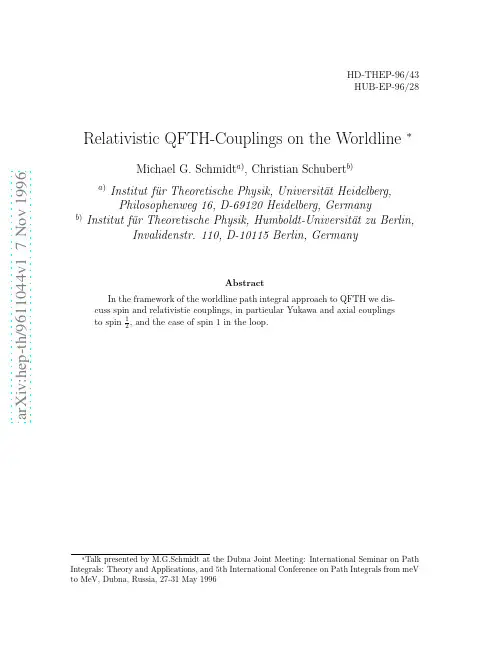
a r X i v :h e p -t h /9611044v 1 7 N o v 1996Relativistic QFTH-Couplings on the Worldline ∗Michael G.Schmidt a ),Christian Schubert b )a )Institut f¨u r Theoretische Physik,Universit¨a t Heidelberg,Philosophenweg 16,D-69120Heidelberg,Germany b )Institut f¨u r Theoretische Physik,Humboldt-Universit¨a t zu Berlin,Invalidenstr.110,D-10115Berlin,GermanyAbstractIn the framework of the worldline path integral approach to QFTH we dis-cuss spin and relativistic couplings,in particular Yukawa and axial couplings to spin 1∗Talk presented by M.G.Schmidt at the Dubna Joint Meeting:International Seminar on Path Integrals:Theory and Applications,and 5th International Conference on Path Integrals from meV to MeV,Dubna,Russia,27-31May 1996IntroductionInteracting relativistic particles are usually described by relativistic local quan-tumfieldmoving on a space-time worldline xµ(τ)and interacting with backgroundfields.We here restrict our discussion to effective1-loop actions,i.e.the particles are running on a closed loop.For a massive complex scalar in the loop one has(euclidean action;singularity at T=0to be renormalized)Γscalar=−log det(−D2+V(x)+m2)= ∞0dT4+ig˙xµ(τ)Aµ(x(τ))+V(φ(x(τ))(2)if one has an(possibly nonabelian,matrix valued in color space)gauge background field and a“potential”(the second derivative of the QFTH-potential),e.g.∼φ,φ2 forφ3,φ4theory resp.Indeed this“first quantization”and the backgroundfield method were used intensively in modern string theory.In particular the recurrence to relativistic particles helped to write down nonlinearσ-models for xµ(σ,τ)on the “world sheet”[2].In the limit string tension1T.(3) It fulfils1∂τ2G B(τ,τ′)=δ(τ−τ′)−1mass”-coordinate of theloop.More general background charges ρ(τ)instead of1Te −m2T∞n =0(−1)n4(6)×τ1=T 0dτ2...τn −1 0dτnnj =1e y (τj )·D V (x (0))+ig ˙y µj (τj )y ρj (τj )1dηj ηj e ηj y (τj )·D F ρj µj (x (0)).In the case where only the potential is present this immediately leads to the minimal number of invariants.Also for the case of gauge interactions it is the most efficient form for obtaining the heat kernel expansion.Such expansions can be used in the calculation of fluctuation corrections around quasiclassical configurations.The effective action (euclidean notation)for gauge fields A µcoupling minimallyto Dirac particles L =¯ψO ψwith O =O +=(∂µ+ig A µ)γµis ΓDirac =log det O =12Tr log(−D 2µ1+gσµνF µν).(7)This contains a Dirac matrix valued potential but otherwise is similar to the scalartheory (“second order formalism”).One can substitute the Dirac matrix trace by a Grassmann variable integration over ψ(τ)[6,5,9]ΓDirac =−2∞dT2ψµ˙ψµ(τ)−igψµ(τ)ψν(τ)F µν(x (τ))(9)with a corresponding Green functionψµ(τ)ψν(τ′) =12δµνsign(τ−τ′).(10)2Surprisingly L D W L is supersymmetric(a remnant of local SUSY),i.e.invariant un-derδxµ=−2ηψµ,δψµ=η˙xµwith a constant Grassmann parameterη,though the boundary conditions break the SUSY.Introducing superfields in superspace ˆτ(τ,θ)( dθθ=1):Xµ(ˆτ)=xµ(τ)+√∂θ−θ∂4DXµD2Xµ−igDXµAµ(X) .(11) Thus the formalism is manifestly supersymmetric[6,8,10]and one can get the effective action with Dirac particles in the loop from the one with scalars by just substituting super Green functionsˆG(ˆτ,ˆτ′)=GB(τ,τ′)+θθ′G F(τ,τ′)(12) in the bosonic calculation.This also explains the so-called“chain”-rule:substitute (index-)closed chains of˙G B(τ,τ′)=∂2couplingsCuriously the Yukawa coupling L Yuk=¯ψ(−iλφ)ψwas not translated to the worldline formulation until our recent work with M.Mondrag´o n and L.Nellen[11]. In a dimensional reduction approach it can be interpreted as a gauge coupling in a fifth dimension(after some redefinition ofγµ).Introducing a new superfield X5=˜x5+√2DX5=√4¯XD¯X+iλφ(Xµ)¯X(ˆτ)=x252ψ5˙ψ5+iλ(x5φ(x)−2ψ5ψµ∂µφ(x)).(14)Integrating out the auxiliaryfield x5we obtain1byΓ=Tr log O=12Tr(log O−log O+)(17)withOO+=−D2+gσµνVµν+g5γ5σµνAµν+iλγµ∂µφ−λ′γ5γµ∂µφ′+2(im+iλφ−γ5λ′φ′)ig5γ5γµAµ+m2+2mλφ+λ2φ2+λ′2φ′2(18) where Vµν,Aµνare thefield strengths.The derivative of the second term in(17) with respect to the backgroundfield U(U=A,φ′in the following)can be written asδδUO+−OδO+OO+ .(19) This“second order”formalism can be translated to the worldline formulation with a purely Grassmann even Lagrangian if one introduces two additional superfields¯X and X′appearing in the coupling to scalars/pseudoscalars as in(14).The new piece of the worldline action is particularly simple if expressed in superfields.We proposed[13]S W L= dτdθ 14¯XD¯X+1eθχgaugefixed to e= 2,χ=0on the circle.The form of the axial coupling with both¯X,X′involved is surprising.Written out in components this is a lengthy expression[13].The imaginary part(19)can be worked out and also translated to worldline languageΓ′U=δT [DXµ][D¯X][DX′](−1)FΩU e−S W L(21)withΩφ′=−iλ′√4D2XµDXµ+1We have tested our worldline action by calculating[13]a collection of ampli-tudesfirst in the conventional Dirac-Feynman,then in second order,andfinally in the worldline formalism.In particular,we could reproduce PCAC and the axial anomaly;we can also derive higher order terms in the1-loop effective action.In recent publications[14,16]it was argued that O and O+can be arranged in a8×8spinor matrix corresponding to a6-dimensional space,thus explaining the need for ourfields¯X,X′.The6-dimensionalγ-matrices can be substituted by Grassmannψ’s and our worldline Lagrangian is reproduced and generalized in an elegant way.There is a subtle technical point[13,17]about either integrating out the auxiliaryfields x5,x6belonging to¯X,X′or contracting them in Green functions if the correctfield theory results are to be obtained.Spin1in the loopThe case of massless spin1gauge bosons coupling to a gauge boson background is particularly important in QCD applications.In the covariant’t Hooft-Feynman background gauge the1-loop action has the Schwinger formΓ(A)=1TTr exp(−ˆhT)(23)with the(color and Lorentz)matrix valued Hamiltonianˆh abµν=−D acρD cbρδµν−2ig F abµν(x).(24) One can evaluate this by a“bosonized”worldline path integral including a matrix valued potential but motivated by the spin1∂xµ,ˆ¯ψ=∂2limC→∞ ∞0dT2antiper.− per. [Dψµ][D¯ψµ]×Tr P exp − T0dτ ˙x2µand fermionic Green functionsG C per.=− θ(−τ)±θ(τ)e−CT e Cτ/(1∓e−CT)(27) antiper.similar but not identical to the expressions in[5].We should stress that(26)is the result of a rigorous derivation,will lead to correct gluon amplitudes,and thus is a good starting point for deriving Bern-Kosower type1-loop rules.As a simple application we have rederived[18]the1-loop action in a constant pseudo-abelian background.Considering the multiloop case it is not so obvious that introducing Grassmann variables to represent spin is an equally efficient way as it is for spin1References[1]R.P.Feynman,Phys.Rev.80(1950)440[2]E.S.Fradkin,A.A.Tseytlin,Phys.Lett.B163(1985)123[3]R.R.Metsaeev,A.A.Tseytlin,Nucl.Phys.B298(1988)109[4]Z.Bern,D.A.Kosower,Phys.Rev.Lett.66(1991)1669;Nucl.Phys.B379(1992)451[5]M.J.Strassler,Nucl.Phys.B385(1992)145;SLAC-PUB-5978(1992)[6]A.M.Polyakov,Gauge Fields and Strings(Harwood,1987)[7]M.G.Schmidt,C.Schubert,Phys.Lett.B318(1993)438;D.Fliegner,M.G.Schmidt,C.Schubert,Z.f.Phys.C64(1994)111;D.Fliegner,P.Haberl,M.G.Schmidt,C.Schubert,Discourses in Mathematicsand its Applications,Texas A+M Univ.,Dep.of Math.(1995),p.87(hep-th/9411177)[8]O.D.Andreev,A.A.Tseytlin,Phys.Lett.B207(1988)157[9]D.G.C.McKeon,A.Rebhan,Phys.Rev.D48(1993)2891[10]M.G.Schmidt,C.Schubert,Phys.Rev.D53(1996)2150[11]M.Mondrag´o n,L.Nellen,M.G.Schmidt,C.Schubert,Phys.Lett.B351(1995)200[12]L.Brink,P.Di Vecchia,P.Howe,Nucl.Phys.B118(1977)76[13]M.Mondrag´o n,L.Nellen,M.G.Schmidt,C.Schubert,Phys.Lett.B366(1996)212[14]E.D’Hoker,D.G.Gagn´e,UCLA/95/TEP/22(hep-th/9508131);UCLA/95/TEP/35(hep-th/9512080)[15]L.Alvarez-Gaum´e,Comm.Math.Phys.90(1983)161;L.Alvarez-Gaum´e,E.Witten,Nucl.Phys.B234(1983)269[16]J.W.van Holten,NIKHEF-H/95-050(hep-th/9508136)[17]D.G.Gagn´e,UCLA/96/TEP/13(hep-th/9604199)[18]M.Reuter,M.G.Schmidt,C.Schubert,IASSNS-HEP-96/90(hep-th/9610191)[19]K.Roland,Phys.Lett.B289(1992)148;K.Roland,H.-T.Sato,NBI-HE-96-19(hep-th/9604152);P.Di Vecchia,A.Lerda,L.Magnea,K.Marotta,Phys.Lett.351B(1995)445 (hep-th/9502156);and with R.Russo,Nordita95/86P(hep-th/9601143)7。
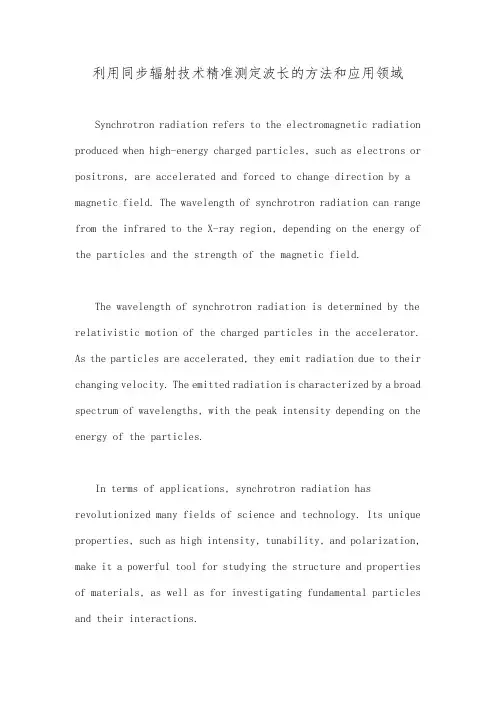
利用同步辐射技术精准测定波长的方法和应用领域Synchrotron radiation refers to the electromagnetic radiation produced when high-energy charged particles, such as electrons or positrons, are accelerated and forced to change direction by a magnetic field. The wavelength of synchrotron radiation can range from the infrared to the X-ray region, depending on the energy of the particles and the strength of the magnetic field.The wavelength of synchrotron radiation is determined by the relativistic motion of the charged particles in the accelerator. As the particles are accelerated, they emit radiation due to their changing velocity. The emitted radiation is characterized by a broad spectrum of wavelengths, with the peak intensity depending on the energy of the particles.In terms of applications, synchrotron radiation has revolutionized many fields of science and technology. Its unique properties, such as high intensity, tunability, and polarization, make it a powerful tool for studying the structure and properties of materials, as well as for investigating fundamental particles and their interactions.中文回答:同步辐射指的是当高能带电粒子(如电子或正电子)在磁场的作用下被加速并强制改变方向时所产生的电磁辐射。
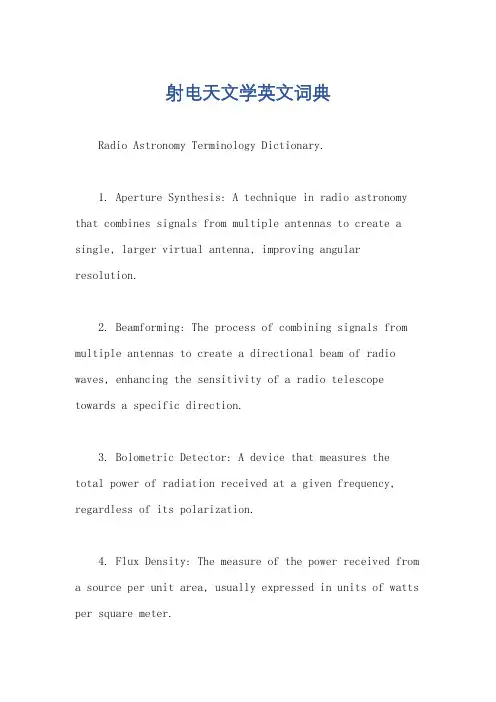
射电天文学英文词典Radio Astronomy Terminology Dictionary.1. Aperture Synthesis: A technique in radio astronomy that combines signals from multiple antennas to create a single, larger virtual antenna, improving angular resolution.2. Beamforming: The process of combining signals from multiple antennas to create a directional beam of radio waves, enhancing the sensitivity of a radio telescope towards a specific direction.3. Bolometric Detector: A device that measures thetotal power of radiation received at a given frequency, regardless of its polarization.4. Flux Density: The measure of the power received froma source per unit area, usually expressed in units of watts per square meter.5. Interferometer: A device that combines signals from two or more antennas to measure the phase differences between the received signals, enabling the determination of the angular position of radio sources.6. Radio Telescope: A telescope designed to receive and analyze radio waves from celestial objects.7. Spectral Line: A narrow emission or absorption feature in the radio spectrum of a celestial object, resulting from transitions between quantum states of atoms or molecules.8. Synchrotron Radiation: Radiation emitted by charged particles moving in circular paths at nearly the speed of light, a common phenomenon in astrophysical objects with strong magnetic fields.9. Telescope Beam: The region of space through which a radio telescope is sensitive to radiation, typically described by its shape and size.10. Very Large Array (VLA): A radio telescopeconsisting of multiple antennas arranged in a large array, used for high-resolution observations of celestial objects.11. Zenith Angle: The angle between the vertical direction and a line from the observer to a celestial object, measured from the zenith point overhead.12. Angular Resolution: The ability of a radiotelescope to distinguish between two closely spaced sources, measured as the smallest angular separation at which two sources can be resolved.13. Astrometry: The branch of astronomy dealing withthe measurement of positions and movements of celestial objects.14. Bandwidth: The range of frequencies over which a radio receiver is sensitive to incoming radiation.15. Continuum Radiation: The smooth, featurelesscomponent of the radio spectrum of a celestial object, resulting from the superposition of many spectral lines.16. Cosmic Microwave Background (CMB): Radiation left over from the Big Bang, detected as a faint microwave signal filling all directions in the sky.17. Dynamic Range: The ratio between the strongest and weakest signals that a radio telescope can detect simultaneously.18. Faraday Rotation: The rotation of the plane of polarization of electromagnetic waves as they pass through a magnetized plasma, caused by the interaction between the magnetic field and the plasma's charged particles.19. Frequency Synthesiser: A device that generates precise radio frequencies for use in radio telescopes, ensuring accurate measurements of celestial objects.20. Noise Temperature: A measure of the random fluctuations in a radio receiver's output signal, expressedas an equivalent temperature.21. Point Source: A celestial object that appears as a single point of radiation in the sky, with no angular structure resolvable by a radio telescope.22. Radio Galaxy: A galaxy that emits significant amounts of radio radiation, often due to synchrotron radiation from relativistic electrons in its magnetic field.23. Redshift: The increase in wavelength of electromagnetic radiation emitted by a celestial object due to its motion away from the observer, resulting in a shift towards longer wavelengths in the spectrum.24. Single-Dish Telescope: A radio telescope consisting of a single large antenna, used for observations ofcelestial objects.25. Spectral Index: A measure of the steepness or flatness of a celestial object's radio spectrum, indicating the relative amounts of radiation at different frequencies.26. Synthesis Imaging: The process of combining signals from multiple antennas in a radio telescope array to create an image of a celestial object, improving both angular resolution and sensitivity.27. Telescope Time: The amount of time allocated to a specific research project for observations with a radio telescope.28. Telescope Sensitivity: The ability of a radio telescope to detect weak radio signals from celestial objects, measured as the minimum flux density detectable.29. Tidal Force: The force acting on a body due to the differential gravitational attraction of two other bodies, such as the Moon and Sun on Earth, causing tides.30. Total Power Map: A map of the sky created by measuring the total power of radio radiation received from different directions, used to identify and study celestial objects.This is a brief overview of some key terms related to radio astronomy. The field is vast and diverse, and this list is not exhaustive. However, it provides a solid foundation for understanding the language and concepts of radio astronomy.。
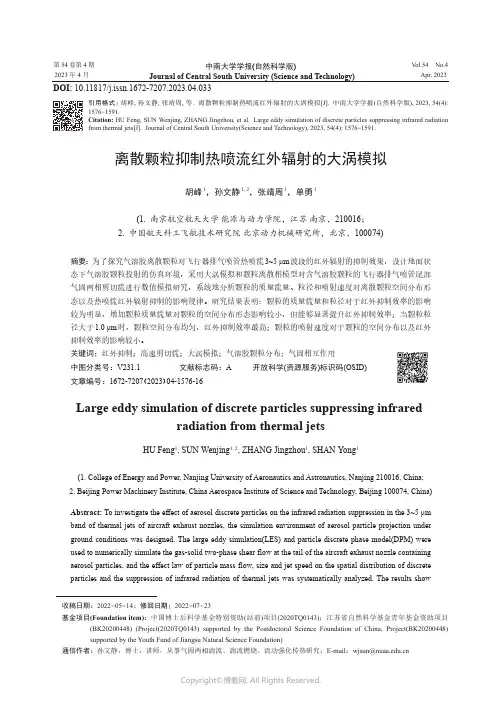
第 54 卷第 4 期2023 年 4 月中南大学学报(自然科学版)Journal of Central South University (Science and Technology)V ol.54 No.4Apr. 2023离散颗粒抑制热喷流红外辐射的大涡模拟胡峰1,孙文静1, 2,张靖周1,单勇1(1. 南京航空航天大学 能源与动力学院,江苏 南京,210016;2. 中国航天科工飞航技术研究院 北京动力机械研究所,北京,100074)摘要:为了探究气溶胶离散颗粒对飞行器排气喷管热喷流3~5 μm 波段的红外辐射的抑制效果,设计地面状态下气溶胶颗粒投射的仿真环境,采用大涡模拟和颗粒离散相模型对含气溶胶颗粒的飞行器排气喷管尾部气固两相剪切流进行数值模拟研究,系统地分析颗粒的质量流量、粒径和喷射速度对离散颗粒空间分布形态以及热喷流红外辐射抑制的影响规律。
研究结果表明:颗粒的质量流量和粒径对于红外抑制效率的影响较为明显,增加颗粒质量流量对颗粒的空间分布形态影响较小,但能够显著提升红外抑制效率;当颗粒粒径大于1.0 μm 时,颗粒空间分布均匀,红外抑制效率最高;颗粒的喷射速度对于颗粒的空间分布以及红外抑制效率的影响较小。
关键词:红外抑制;高速剪切流;大涡模拟;气溶胶颗粒分布;气固相互作用中图分类号:V231.1 文献标志码:A 开放科学(资源服务)标识码(OSID)文章编号:1672-7207(2023)04-1576-16Large eddy simulation of discrete particles suppressing infraredradiation from thermal jetsHU Feng 1, SUN Wenjing 1, 2, ZHANG Jingzhou 1, SHAN Yong 1(1. College of Energy and Power, Nanjing University of Aeronautics and Astronautics, Nanjing 210016, China;2. Beijing Power Machinery Institute, China Aerospace Institute of Science and Technology, Beijing 100074, China)Abstract: To investigate the effect of aerosol discrete particles on the infrared radiation suppression in the 3~5 μm band of thermal jets of aircraft exhaust nozzles, the simulation environment of aerosol particle projection under ground conditions was designed. The large eddy simulation(LES) and particle discrete phase model(DPM) were used to numerically simulate the gas-solid two-phase shear flow at the tail of the aircraft exhaust nozzle containing aerosol particles, and the effect law of particle mass flow, size and jet speed on the spatial distribution of discreteparticles and the suppression of infrared radiation of thermal jets was systematically analyzed. The results show收稿日期: 2022 −05 −14; 修回日期: 2022 −07 −23基金项目(Foundation item):中国博士后科学基金特别资助(站前)项目(2020TQ0143);江苏省自然科学基金青年基金资助项目(BK20200448) (Project(2020TQ0143) supported by the Postdoctoral Science Foundation of China; Project(BK20200448) supported by the Youth Fund of Jiangsu Natural Science Foundation)通信作者:孙文静,博士,讲师,从事气固两相湍流、湍流燃烧、流动强化传热研究;E-mail :**************.cnDOI: 10.11817/j.issn.1672-7207.2023.04.033引用格式: 胡峰, 孙文静, 张靖周, 等. 离散颗粒抑制热喷流红外辐射的大涡模拟[J]. 中南大学学报(自然科学版), 2023, 54(4): 1576−1591.Citation: HU Feng, SUN Wenjing, ZHANG Jingzhou, et al. Large eddy simulation of discrete particles suppressing infrared radiation from thermal jets[J]. Journal of Central South University(Science and Technology), 2023, 54(4): 1576−1591.第 4 期胡峰,等:离散颗粒抑制热喷流红外辐射的大涡模拟that the effect of particle mass flow and size on infrared radiation suppression rate is obvious. With the increase of particle mass flow, its effect on the spatial distribution of particles is small, but the infrared suppression efficiency is significantly improved. When the particle diameter is 1.0 μm, the particle space distribution is uniform and the highest infrared suppression rate is achieved. However, the particle injection speed has less effect on the spatial distribution of particles and infrared radiation suppression efficiency.Key words: infrared suppressing; high-speed shear flow; large eddy simulation; aerosol particle distribution; gas-solid interactions气溶胶红外隐身技术是一种主动型应急红外对抗技术,该技术利用附加的机载引气装置,将细微颗粒喷射在发动机热喷流周围形成气溶胶云,借此对排气喷管热内腔和热喷流的强红外辐射进行遮蔽和散射。
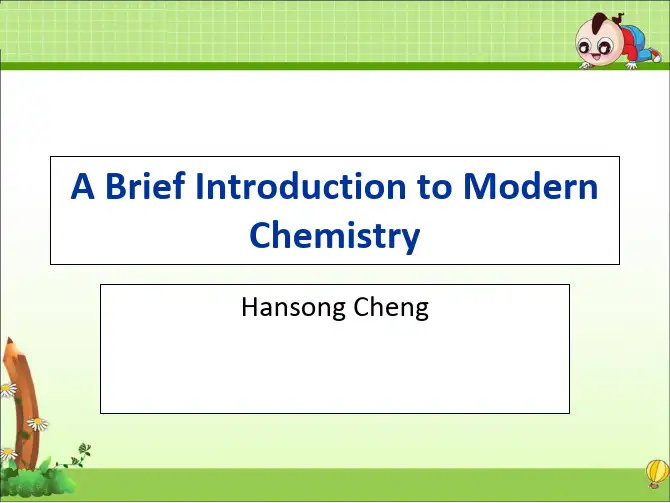
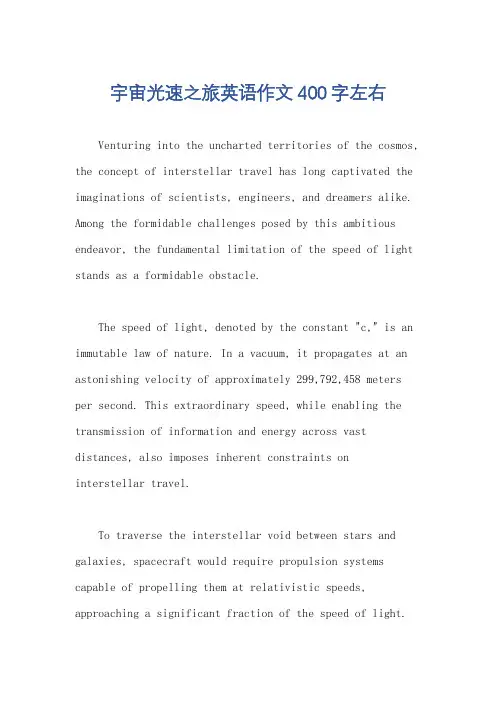
宇宙光速之旅英语作文400字左右Venturing into the uncharted territories of the cosmos, the concept of interstellar travel has long captivated the imaginations of scientists, engineers, and dreamers alike. Among the formidable challenges posed by this ambitious endeavor, the fundamental limitation of the speed of light stands as a formidable obstacle.The speed of light, denoted by the constant "c," is an immutable law of nature. In a vacuum, it propagates at an astonishing velocity of approximately 299,792,458 meters per second. This extraordinary speed, while enabling the transmission of information and energy across vast distances, also imposes inherent constraints oninterstellar travel.To traverse the interstellar void between stars and galaxies, spacecraft would require propulsion systems capable of propelling them at relativistic speeds, approaching a significant fraction of the speed of light.However, as a spacecraft approaches these relativistic velocities, several fundamental challenges arise.Firstly, the time dilation effect of special relativity becomes increasingly pronounced. As a spacecraft approaches the speed of light, time slows down relative to an observer at rest. This means that the crew of a relativistic spacecraft would experience time at a slower rate than those on Earth. For example, a hypothetical spacecraft traveling at 90% of the speed of light for one year would return to Earth after only two years, as measured by the Earth's clocks, while the crew on board would have experienced approximately two and a half years.Another significant challenge is the relativistic increase in mass. As a spacecraft approaches the speed of light, its mass increases exponentially. This means that the amount of energy required to accelerate a spacecraft to relativistic speeds becomes prohibitively large. Conventional rocket propulsion, based on the principle of action and reaction, would be inadequate for interstellar travel due to the exponential increase in energyrequirements.Furthermore, the interstellar medium is far from being a perfect vacuum. It contains various particles, including interstellar dust and gas. Collisions with these particles at relativistic speeds could generate enormous heat and radiation, posing significant hazards to the crew and spacecraft. Adequate shielding and protection measures would be essential to mitigate these risks.Despite these formidable challenges, the pursuit of interstellar travel continues to inspire scientific research and technological innovation. Scientists and engineers are exploring various theoretical and experimental approaches to overcome the limitations imposed by the speed of light. These include concepts such as warp drives, which propose the manipulation of spacetime to create a "bubble" around the spacecraft, allowing it to travel faster than the speed of light without violating the laws of physics.Additionally, the development of advanced propulsionsystems, such as ion propulsion and nuclear fusion propulsion, offers potential solutions for achieving relativistic speeds. These propulsion systems couldgenerate continuous thrust over extended periods, enabling spacecraft to accelerate gradually and reach relativistic velocities without encountering the same exponential energy requirements as conventional rocket propulsion.While the challenges of interstellar travel are immense, they are not insurmountable. Through continued scientific research, technological advancements, and unwavering determination, humanity may one day venture beyond the confines of our solar system and embark on extraordinary journeys to distant stars and galaxies.。
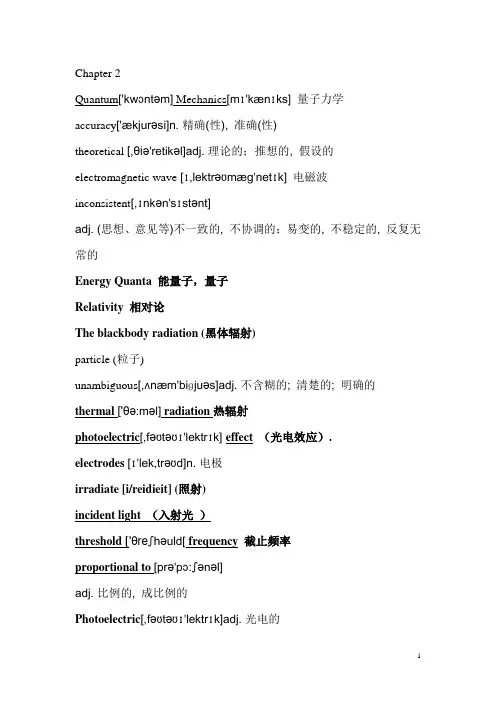
Chapter 2Quantum['kwɔntəm] Mechanics[mɪ'kænɪks]量子力学accuracy['ækjurəsi]n. 精确(性), 准确(性)theoretical [,θiə'retikəl]adj. 理论的;推想的, 假设的electromagnetic wave [ɪ,lektrəʊmæg'netɪk]电磁波inconsistent[,ɪnkən'sɪstənt]adj. (思想、意见等)不一致的, 不协调的;易变的, 不稳定的, 反复无常的Energy Quanta 能量子,量子Relativity 相对论The blackbody radiation (黑体辐射)particle (粒子)unambiguous[,ʌnæm'biɡjuəs]adj. 不含糊的; 清楚的; 明确的thermal ['θə:məl] radiation热辐射photoelectric[,fəʊtəʊɪ'lektrɪk] effect (光电效应).electrodes [ɪ'lek,trəʊd]n. 电极irradiate [i/reidieit] (照射)incident light (入射光)threshold ['θreʃhəuld[ frequency 截止频率proportional to [prə'pɔ:ʃənəl]adj. 比例的, 成比例的Photoelectric[,fəʊtəʊɪ'lektrɪk]adj. 光电的intensity [in'tensiti]n. 强烈, 剧烈;(感情的)强烈程度photoelectron[,fəutəui'lektrɔn]n. 光电子kinetic [kɪ'netɪk, kaɪ-]adj. <物>动力的,由运动引起的electrode [ɪ'lek,trəʊd]n. 电极emission[ɪ'mɪʃən] n.1.排放物,散发物(尤指气体)2.排放,散发,发出(气体、光、热)eject[i'dʒekt]vt. & vi. 弹出, 喷出, 排出vt. 逐出contamination (污染)hypothesis [hai'pɔθisis]n. 假说, 假设, 前提assumption [ə'sʌmpʃən]n. 假定, 臆断photon [/fəʊ:tɔn]光子;光量子cathode['kæθ,əʊd]n. <电>(-)阴极,负极work function (功函数).equation方程kinetic energy (动能)photon. ['fəʊ,tɔn]n. <物>光子;光量子photoelectron [,fəutəui'lektrɔn]n. 光电子reciprocal ri'siprəkəl (倒数)Wave-Particle Duality [dju(:)'æliti] (波粒二象性)impinges [im/pindʒ] (冲击,撞击)diffuse reflection漫射wavelength 波长scattere.[/skætə]散射mechanism ['mekənizəm]n. (机理)forced vibration [vaɪ'breɪʃən] (受迫振动),oscillate vt. & vi. (使)摆动momentum(动量)collision [kə'liʒən]n. 碰撞, 冲突, 抵触recoils [ri/kɔil] 反冲D e B r o g l i e W a v e(德布罗意波)postulate [/pɔstju/leɪt] (假设matter waves 物质波wave-particle duality [dju(:)'æliti](波粒二象性)filament['fɪləmənt (灯丝)accelerate [æk'seləreit]vt. & vi. (使)加快, (使)增速nickel ['nikəl] (镍).Scattere [/skætə]散射diffract 衍射interference [,ɪntə'fiərəns]干涉grating ['greɪtɪŋ](光栅)magnitude 'mæɡnitju:d] (数量级)protons [/prəʊ/tɔn] (质子)neutrons [/nu:/trɔn] (中子)mechanics [mɪ'kænɪks]n. 力学;机械学;机件;过程;方法radius ['reidjəs (半径)wave theory 波动理论subatomic ['sʌbə'tɔmik]adj. 小于原子的;亚原子的,次原子的particle ['pɑ:tikl]n. 微粒, 颗粒, 〈物〉粒子;极少量;小品词conjugate [/kɔndʒəɡeit]variables [/vɛəriəbl](相关变量), simultaneous [,siməl'teinjəs]adj. 同时发生的; 同时存在的generalized[/dʒenərəlaizd]adj.1.广泛的, 普遍的, 全面的2.非具体的; 整体的angular position (角坐标)angular momentum (角动量momentum [məu'mentəm]n. 动力, 冲力, 势头;〈物〉动量profound [prə'faund]adj. 深度的; 深切的; 深远的;知识渊博的, 见解深刻的, 深奥的diameter [dai'æmitə]n. 直径;放大率electron single-slit diffraction([di'frækʃən]电子单缝衍射slit [slit]vt. 切开, 撕开n. 狭长的口子, 裂缝billiard [/bɪljəd] ball (台球)macroscopic [/mækrə/skɔpɪk] (宏观的)Microscopic [/maɪkrə/skɔpɪk] 微观的rifle [/raifl] (来福枪)bullet [/bulit] (子弹)apparatus [/æpə/reitəs] (仪器)bounced off 反弹probability density function (概率密度函数)precisely [prɪ'saɪsli:]adv. 精确地;恰好;细心地;对, 的确如此dice [dais]骰子violate ['vaiəleit]vt. 违反, 违背;亵渎;侵犯, 妨碍bizarre [bi/zɑ:] (怪诞的tick [tik]n. 钟的嘀嗒声;(表示正确无误的)记号;证券价格的增额;(寄生于体大动物的吸血小虫)壁虱vt. & vi.1.发出滴答声2.标以记号3.激怒kinetic energy 动能relativistic quantum mechanics (相对论量子力学non-relativistic quantum mechanics (非相对论量子力学) . hypotheses [hai/pɔθisiz]臆测,假定one-dimensional (一维的),constant ['kɔnstənt] (常数)portion ['pɔ:ʃən]n. 一部分, 一份vt. 把…分成份额, 分配the technique of separation of variables (分离变量法Substituting ['sʌbstitju:tiŋ]n. 取代denote [di'nəut]vt. 为…的符号; 为…的名称;指示; 指出dynamic [dai'næmik] (动力学的complex conjugate function (复共轭)normalizing condition 归一化条件coefficient [,kəʊə'fɪʃənt系数).derivative [di/rivətiv](导数)finite ['fainait]adj. 有限的, 有限度的;〈语〉限定的single-valued 单值的state superposition principle (态叠加原理)traveling wave (行波),parameter [pə'ræmitə]n. (限定性的)因素, 特性, 界限;〈物〉〈数〉参量, 参数Infinite ['infinit]adj. 无限的, 无穷的, 无边无际的Potential Well (势阱)bound particle (束缚粒子).explicit [iks'plisit]adj. 详述的, 明确的, 明晰的;直言的, 毫不隐瞒的, 露骨的discrete [dis'kri:t]adj. 分离的, 不相关联的energy levels (能级)dimension [di'menʃən]n. 尺寸, 维度standing wave (驻波quantization量子化quantum states (量子态)Barrier ['bæriə] (势垒)incident particle (入射粒子)a flux ([flʌks]of incident particles一束入射离子流originate [ə'ridʒineit]vi. 起源于, 来自, 产生transmission coefficient (透射系数),impinge [im/pindʒ]碰撞penetrate ['penitreit] (穿透)tunneling (tunnel [/tʌnəl]) effect (隧道效应contradict [,kɔntrə'dikt]vt. & vi. 反驳, 否认…的真实性vt. 与…发生矛盾, 与…抵触tunnel diode (隧道二级管)horizontal [,hɔri'zɔntəl]adj. 水平的, 与地平线平行的ionize ['aɪə,naɪz]vt. & vi. (使)电离,(使)成离子molecule分力theoretical [,θiə'retikəl]adj. 理论的;推想的, 假设的visualized ['viʒuəlaiz]vt. 在脑中使(某人或某物)形象化, 设想, 想像pulse [pʌls]n. 脉搏;脉冲vi. (心脏)跳动; 脉动attosecond阿秒periphery [pə'rɪfəri:]n. 外围;边缘spectrometry光谱测定法dynamics [dai'næmiks]n. 动力学、力学;facilitate [fə'siliteit]vt. 使便利, 减轻…的困难rectangular [rek/tæŋɡjulə](长方形的; 矩形的coulomb [/ku:lɔm]attraction (库仑引力)permittivity [/pə:mi/tiviti] (介電常數)spherical coordinates [/sfɪərɪkəl] [kəu/ɔ:dineit] (球坐标). Laplace operator (拉普拉斯算符)spherical['sfɪərɪkəl, 'sfer-]adj. 球形的,球面的;天体的coordinate[kəu'ɔ:dineit]vt. 使协调; 使调和adj. 同等的, 并列的n. 〈数〉坐标principle quantum number (主量子数);angular momentum quantum number (角量子数magnetic quantum number (磁量子数).Correspond[,kɔris'pɔnd]vi. 相符合, 相一致;相当, 相类似;通信discrete[dis'kri:t]adj. 分离的, 不相关联的,分立的symmetric对称的Bohr radius (玻尔半径emanate ['emə,neɪt]vi. 从…处传出;传出nucleus ['nju:kliəs]n. (原子)核;中心, 核心plot 绘制,作图electron cloud (电子云energy shell能量壳层yield [ji:ld]vt. & vi. 生产, 出产, 带来;evolve [i'vɔlv]vt. & vi. 演变; 进化Periodic ([,piəri'ɔdik])T able (周期表) initial [i'niʃəl]adj. 最初的, 开头的electron spin (电子自旋).spin [spin]vt. & vi. 使…旋转vt. 杜撰exclusion [ɪk'sklu:ʒən]n. 拒绝,排除n. 排外主义helium (氦),inert [ɪ/nɜ:t](惰性的valence ['veiləns]n. (化合)价,原子价deviate [/di:vieit] (偏离)。
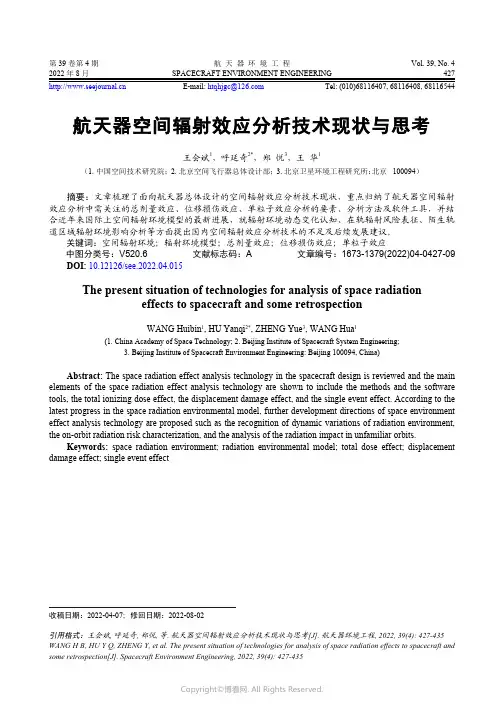
第 39 卷第 4 期航 天 器 环 境 工 程Vol. 39, No. 4 2022 年 8 月SPACECRAFT ENVIRONMENT ENGINEERING427 E-mail: ***************Tel: (010)68116407, 68116408, 68116544航天器空间辐射效应分析技术现状与思考王会斌1,呼延奇2*,郑 悦3,王 华1(1. 中国空间技术研究院; 2. 北京空间飞行器总体设计部; 3. 北京卫星环境工程研究所:北京 100094)摘要:文章梳理了面向航天器总体设计的空间辐射效应分析技术现状,重点归纳了航天器空间辐射效应分析中需关注的总剂量效应、位移损伤效应、单粒子效应分析的要素、分析方法及软件工具,并结合近年来国际上空间辐射环境模型的最新进展,就辐射环境动态变化认知、在轨辐射风险表征、陌生轨道区域辐射环境影响分析等方面提出国内空间辐射效应分析技术的不足及后续发展建议。
关键词:空间辐射环境;辐射环境模型;总剂量效应;位移损伤效应;单粒子效应中图分类号:V520.6文献标志码:A文章编号:1673-1379(2022)04-0427-09 DOI: 10.12126/see.2022.04.015The present situation of technologies for analysis of space radiationeffects to spacecraft and some retrospectionWANG Huibin1, HU Yanqi2*, ZHENG Yue3, WANG Hua1(1. China Academy of Space Technology; 2. Beijing Institute of Spacecraft System Engineering;3. Beijing Institute of Spacecraft Environment Engineering: Beijing 100094, China)Abstract: The space radiation effect analysis technology in the spacecraft design is reviewed and the main elements of the space radiation effect analysis technology are shown to include the methods and the software tools, the total ionizing dose effect, the displacement damage effect, and the single event effect. According to the latest progress in the space radiation environmental model, further development directions of space environment effect analysis technology are proposed such as the recognition of dynamic variations of radiation environment, the on-orbit radiation risk characterization, and the analysis of the radiation impact in unfamiliar orbits.Keywords: space radiation environment; radiation environmental model; total dose effect; displacement damage effect; single event effect收稿日期:2022-04-07;修回日期:2022-08-02引用格式:王会斌, 呼延奇, 郑悦, 等. 航天器空间辐射效应分析技术现状与思考[J]. 航天器环境工程, 2022, 39(4): 427-435 WANG H B, HU Y Q, ZHENG Y, et al. The present situation of technologies for analysis of space radiation effects to spacecraft and some retrospection[J]. Spacecraft Environment Engineering, 2022, 39(4): 427-4350 引言航天器轨道空间辐射环境不仅具有复杂的空间分布,而且随时间不断变化,包括空间分布位置的改变和粒子通量强弱程度的剧烈变化,这些变化与太阳爆发性活动及其引发的近地空间环境扰动事件有关[1]。
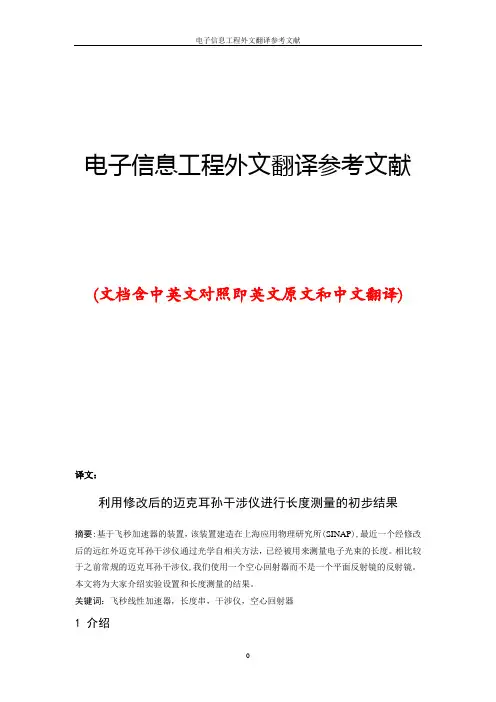
电子信息工程外文翻译参考文献(文档含中英文对照即英文原文和中文翻译)译文:利用修改后的迈克耳孙干涉仪进行长度测量的初步结果摘要:基于飞秒加速器的装置,该装置建造在上海应用物理研究所(SINAP),最近一个经修改后的远红外迈克耳孙干涉仪通过光学自相关方法,已经被用来测量电子光束的长度。
相比较于之前常规的迈克耳孙干涉仪,我们使用一个空心回射器而不是一个平面反射镜的反射镜。
本文将为大家介绍实验设置和长度测量的结果。
关键词:飞秒线性加速器,长度串,干涉仪,空心回射器1 介绍最近关于电子脉冲压缩的实验产生高峰值电流和亮度飞秒电子串。
关于短束源自于高质量光束的潜在应用要求这方面一起了广泛兴趣。
高质量的核物理加速器,自由电子激光器驱动加速器,下一代线性对撞机,第四代光源都需要短时间光束脉冲。
同时,在进程中对诊断的短电子串的研究也起了重要作用。
有几种已经使用或正在开发的方法去测量短电子串的长度。
这些一般分为两类:频域方法和时域方法。
众所周知,在时域测量长度的方法中使用条纹相机,条纹相机已经证实是限于串长度超过200 fs ,此外,条纹相机昂贵并且测量系统复杂。
相对于时域测量方法,频域测量使用相干过渡辐射(CTR )从金属箔在测量飞秒脉冲的短电子中已经显现出前景。
本文我们首先从短电子串方面给出了基于一代的高强度相干渡越辐射的理论和试验研究,然后讨论该方法基于相干渡越辐射测量束飞秒的长度,并从改进电子实验装置给出了串长度测量的结果。
最后,我们分析了空气湿度对串长度测量的影响,并且阐释了对未来研究的计划。
2 理论背景2.1 相干渡越辐射源自于相对论性电子串辐射如同步加速器辐射跃迁辐射等,本质上有较广的范围,如果辐射的波长短于电子串长度,这个阶段的辐射电子不同于彼此,所以辐射是不连贯的。
另一方面,如果波长较长的串长度,辐射是连贯的并且辐射强度的平方成正比每串数字电子。
光谱强度发出一束N 粒子:11()()(1)()|()|tot I NI N N I f λλλλ=+- (2-1)这里1()I λ是靠单电子辐射的强度,()f λ是串形成因素,这是傅里叶变换的规范化的电子密度分布()S Z 。
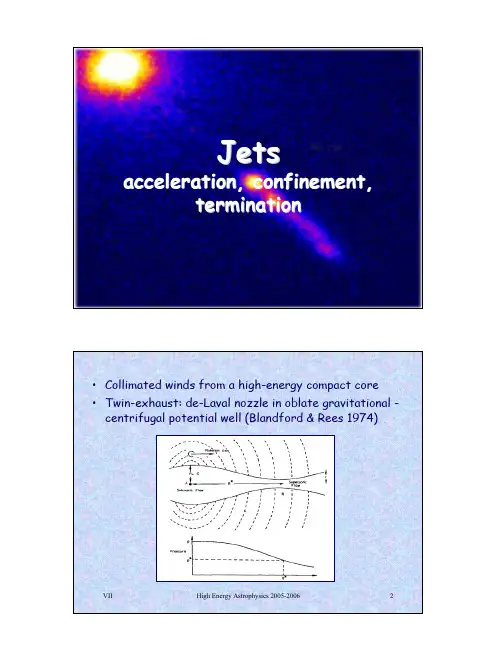
Jetsacceleration, confinement, termination VII High Energy Astrophysics 2005-20062•Collimated winds from a high-energy compact core •Twin-exhaust: de-Laval nozzle in oblate gravitational -centrifugal potential well (Blandford & Rees 1974)VII High Energy Astrophysics 2005-20063=⇒The twin-exhaust model (Blandford &Rees 1974)•First physical model to deal with launching of the jets and its propagation and termination in the external medium•Nucleus:—an unspeci fied dense,cool,rotating gas cloud in gravita-tional hydrostatic equilibrium (any accretion disk fits inthis scheme)—continuously produces a light,hot relativistic gas compo-nent (γ=4/3)—buoyancy forces push the relativistic gas along the leastresistance direction ,i.e.along the rotation axis•Two opposite channels are formed in the nucleus containing a hot gas in stagnation condition•Study the dynamics of the system in an almost 1-D con figu-ration as consistent with the geometry of the potential well ofthe nucleusA =cross section of the channelT ik =wu i u k +pg ik momentum-energy tensor of relativistic gasv =ucγ−11-D flow velocityp =Kn 4/3equation of statew =4p flow enthalpy VII High Energy Astrophysics 2005-20064•Conservation equationsmomentumQ =(wu 2+p )A energyL =wu γcA =const (isentropic flow)particles flux J =nuA =const (no leakage)•Stationary flow wγn=const (relativistic Bernoulli)p =p 0γ−4(p 0stagnation pressure)u =¡γ2−1¢1/2="µp 0p¶1/2−1#1/2A =14L c p −3/4p −1/40"µp 0p¶1/2−1#−1/2•If the flow pressure monotonically decreases outwards from the stagnation value p 0,the flow velocity monotonically in-creases from zero and the channel cross section,starting fromin finity ,decreases to a minimum for p c =(4/9)p 0and then in-creases againVII High Energy Astrophysics 2005-20065•The behaviour corresponds to a wind solution in which en-thalpy at stagnation point is progressively transformed intodirected motion by a gravitational nozzle here represented bythe minimum in the channel cross section•The flow momentum is modi fied by interaction at the walls Q =¡u 2+14¢uγL c Q s =√32L c•Location of the nozzle;assume uniform stellar density ρsp (R )=p 0e −R 2/∆2∆=3kT πGρs m p R s =·ln µ94¶¸1/2∆=120T 1/28µρs 104M ¯pc −3¶−1/2pc •For Cygnus A r s ∼10pc and R s ∼200pc:jets are supersonic before this distance VII High Energy Astrophysics 2005-20066•The sonic pointp s =(4/9)p 0A s =3√3L 8p 0c u s =1√2,γs =r 32v s =u s cγ−1s =c √3•Minimum radius of the channel at the nozzle (assuming axial symmetry)r s =µA s π¶1/2∼0.5µL p 0c¶1/2VII High Energy Astrophysics 2005-20067•Funnels in thick accretion disks:–pre-existing channels of given cross-section profile A(z/z 0)from the stagnation point z 0 (Begelman 1984, Abramowicz 1978, Ferrari 1985):–gravitational pull + funnel pressure + radiation or momentum addition 220222222c D(Z)z 2dZ dS S 2Z B dZd 1ργββββγ++−= −s s ()()[]K J 1H L/z GM D(Z)),A(Z)/A(z S(Z)2GM/c,B /c,v v/c,22030s s +−+=====ββγρββVII High Energy Astrophysics 2005-20068MHD winds•Blandford & Payne (1982) include inertia and assume MHD conditions•Stationary axisymmetric MHD flow•The transfield equation)/1(=×+B v E c ()BB rωB v v v along constant / along constant /214/2=−==−++=×+=+=k rB r l k rB h e k t p ϕϕϕωΦπρv v ()()z B z B z z P ∇⋅+∂∂−∂∂−∂∂−=∇⋅B v ππΦρρ41812z vVII High Energy Astrophysics 2005-20069•Self-similar analysis•Solutions scale with spherical radius along a given direction•Magneto-centrifugal acceleration• A wind is launched when the inclination angle of magnetic lines on the disk is < 60°•After launch the flow isdominated by the toroidalmagnetic field imposed byrotation•Collimation along themagnetic axis[][]()2/1000/)(),(),()(',),(r GM f g f r r χχχχξχφχξ==v r VII High Energy Astrophysics 2005-200610•Close to disk:–Centrifugal acceleration drive the gas out –Acceleration by magnetic pressure –Force-free type magnetic fields •Far away from disk:–Acceleration by Lorentz force –Asymptotic speed ~v φ,disk –Field predominantly toroidal –Narrow jets in balance between hoop stress (inward) and magnetic pressure (outward)•Two super-Alfvénic flows:–Poynting flux dominated –Matter dominated •Stability problemspoloidal velocity toroidal velocityVII High Energy Astrophysics 2005-200611•Extension to relativistic flows (Li, Chiueh, Begelman 1992)•Several analytic steady state solutions have been studied along these lines with suitable approximations:–Königl, Contopoulos ⇒force-free magnetic structures–Ferreira ⇒cold jets from Keplerian disks, extended launching zone–Tsinganos and coworkers ⇒azimuthal self-similarity•Bypass energy equation assuming a polytropic law or a fixed geometry•Boundary conditions•StabilityVII High Energy Astrophysics 2005-200612•Analytic solutions are tested numerically to include nonlinear effects:–Electrodynamic solutions, Poynting jets–MHD solutions, fluid and/or Poynting jets•Critical issues in numerical experiments :–The disk is a fixed boundary condition, with or without imposed associated outflow–The magnetic field is initially uniform and parallel to rotation axis (close to the disk is assumed force-free)–The energy equation is rarely solved, substituted by an adiabatic conditionVII High Energy Astrophysics 2005-200613MHD equations for numerical studies of jets VII High Energy Astrophysics 2005-200614Ingredients for modeling–Central object: star or black hole –Accretion disk –Wind and jet –Magnetic fields: turbulent in disk, ordered in magnetosphere,–Boundary layer disk-star/BHjet starBH diskwindmagnetic linesVII High Energy Astrophysics 2005-200615•Examples of MHD jets–Kato, Kudoh, Shibata 2002•Keplerian disk•Sub-Keplerian disk VII High Energy Astrophysics 2005-200616•The sudden infall of the inner part of the disk is related to the toroidal magnetic field stresses generated by differential rotation •These studies simulate relatively short time scales (≈a rotation period) when the acceleration is driven by an initial Alfvén wave launched by the disk collapse onto the central object •No steady state can be proved to be within reach •Jet is typically hollow (prevailing toroidal component)VII High Energy Astrophysics 2005-200617–Casse and Keppens 2002, resistive MHD, infalling disk VII High Energy Astrophysics 2005-200618•Experiments using the high resolution MHD code FLASH(Zanni 2003)•Solve full energy equation •Evolution of a self-consistent disk: heating by Joule dissipation •Initial magnetic field perpendicular to the disk –the inner part of the disk collapses because of magnetic compression –an Alfvèn wave propagate along the magnetic axis – a Poynting jet follows –toroidal magnetic field wrapped around an hollow jet –jet instabilities –flow velocities ≈Keplerian velocitiesVII High Energy Astrophysics 2005-200619Poynting flux jets•Different regime where energy and angular momentum from disks are carried predominantly by e.m. fields •Most relevant for AGN and GRB jets •Analytic steady-state solutions Blandford 1976, Lovelace 1976•Force-free magnetic fields VII High Energy Astrophysics 2005-200620Electrodynamic launch of jets from accretion funnels•Extraction of rotational and gravitational energy from magnetized accretion disks by magnetic stresses •Stationary rotating Newtonian thin disk •Rotating force-free magnetosphere •Angular velocity αconstant along field lines •At the light surface L, B is bent due to poloidal currents supplied by disk (B φ~B p )• E.M. torque on disk •Disk current J ϖsustain poloidal currents and charge neutrality •Charges stream out at high speed as e.m. wind •Poynting flux deposited in particle flux 0)/1(=×+B J E c ρVIIHigh Energy Astrophysics 2005-200621•Scaling along disk• E.M. braking of disk• E.M. wind at large z , no charge separated (inertial effects ?)• E.M. field components at large z•Acceleration of particle flows by J ×B force and collimation by hoop stress causing pinch effect in the plasma1,−∝∝ϖϕJ B disk p ()αG B J r G ⋅−=××=W diskcj pol ρ→1//→−→tor perp pol tor B E B B αϖVIIHigh Energy Astrophysics 2005-200622•A fast jet aligned to the magnetic field •Acceleration:–asymptotic z -velocities of charges in currents produced by high voltages can reach the speed of light•Collimation:–inertial effects are assumed to be weak and the plasma in the currents is bound to field lines –if a (dense) plasma is flowing along the lines magnetic tension balances pressure gradients and hoop stresses can pinch the flow•Stability issuesVIIHigh Energy Astrophysics 2005-200623•Basic structure of the model: disk and dipole•Solution of the Grad-Shafranov equation•Boundary conditions impose collimationΨΨΨΨΨλπΨΨΨΨλπΨλΨΨϕϕϕ∂∂−=∂∂+∂∂−∂∂=∂∂==×∇=≈×∂∂+∂∂−=+=)()(1)(4)()()(4)(0ˆ1ˆ1ˆ2222H H z r r r cH H rB cz r r r z r B p p B B BJ B J B B B VIIHigh Energy Astrophysics 2005-200624Numerical MHD solutions with low plasma densityLovelace and coworkers 1987,Colgate & Li 1998, Camenzind 1987A dipole structure threading a Keplerian diskoriginates a Poynting jet along the axis and a centrifugal wind from the equatorial region Collimation isguaranteed by the toroidal magnetic hoop propagating along the axisVIIHigh Energy Astrophysics 2005-200625General Relativistic SimulationsKoide, Shibata, Kudoh, Meier (2002)Accretion onto Kerr BH: gravitomagnetic effects(Blandford & Znajek 1977, Camenzind 1987)velocitypoloidal and /0B B ϕfluxenergy e.m. and density VII High Energy Astrophysics 2005-200626PropagationPropagation NGC 12653C 449VIIHigh Energy Astrophysics 2005-200627•A way to study the characteristics of the outflows and the environment •Issues:–How do jets survive decollimation ?–Instability: dependence on jet speed (supersonic, relativistic) and density ratio (light jets vs heavy jets)–Radiation from jets, thermal and non-thermal, electron acceleration–Large-scale instabilities and morphologies –Jet slowing down, matter entrainment –Nonlinear effects–Electrodynamics: currents, charge separationVIIHigh Energy Astrophysics 2005-200628JET STABILITY•Interaction with the external medium–boundary layers, Kelvin-Helmholtz instabilities •Intrinsic instabilities–thermal, synchrotron, filamentary •Numerical simulations–linear mode amplification, acoustic wavedissipation, shock formation, turbulent mixing, –transition from unstable modes to turbulence •Saturation of instability–dissipative shocks, radiation, particle accelerationVIIHigh Energy Astrophysics 2005-200629•Analytic and numerical studies of infinite (periodic) jets–Self-similar steady states Begelman, Bicknell, Henriksen, Heyvaerts, etc.–StabilityPringle, Blandford, Ferrari and coworkers, Birkinshaw, Hardee, Hughes, Toth, Keppens, etc.–Radiative effects Micono, Ray, etc.–Magnetic fieldsFerrari and coworkers, Hardee, Baty, Frank, etc.•Jets may suffer strong disturbances and decollimation due to intrinsic instabilities •Instabilities as the source of observed morphologies (knots and wiggles) andrelativistic electron accelerationHardee, Benford and coworkersVIIHigh Energy Astrophysics 2005-2006303-D simulations of infinite hydro jetsMicono et al.2000High resolution PPMVII High Energy Astrophysics 2005-200631Finite jets •MHD heavy jets •3-D simulations •K-H twisting modes •Dense core structure •Formation of twisted filaments•Avoid disruption •Enhanced radiation emission by filamentsHardee and coworkers, ZEUSintensitypolarizationvelocityVIIHigh Energy Astrophysics 2005-200632Relativistic jets3-D hydro SimulationsAloy et al. 1999, GENESISInjection of a filled jet γ=7in pressure equilibrium with ambient Low grid resolution ?densitypressureLorentz factorinternal energybackflowVIIHigh Energy Astrophysics 2005-200633•Perturbations and morphologies in superluminal sourcesAloy et al 2003, GENESIS•Knots are not necessarilyassociated with single shocks •Interplay between flow velocity andphase velocities, relativistic effectsVIIHigh Energy Astrophysics 2005-200634•Stability of MHD jets launched fromKeplerian accretion disks Ouyed et al 2003, ZEUS•3-D MHD simulations•Morphologies from K-H unstable modes: corkscrews, wobbles, knots, twists, etc.Instability saturation: energy transfer from large scale to small scale modesVII High Energy Astrophysics 2005-200635Torino Key ProjectHigh-resolution simulations of relativistic jetsMassaglia et al 2003, PLUTO•γin = 10, Mach = 3•ρjet = 10-3ρamb•Lorentz β, t = 750 t cross•γin = 10, Mach = 30•ρjet = 10-1ρamb•Isosurface γ= 7VII High Energy Astrophysics 2005-200636TerminationTermination 3C3413C473C390P3VIIHigh Energy Astrophysics 2005-200637•Probing jets and intergalactic medium•Ingredients:–Working surface –Hot spots–Cocoons, backflows and confinementBegelman& Cioffi1989jh j amb j h v A A v 12/11−−+≈ρρVII High Energy Astrophysics 2005-200638•Numerical studies of instabilities of finite jets with head•2-D hydro simulations •Light relativistic jets •Intrinsic instability interprets theevolution of the jet structure and cocoon •Relativistic jets more stableHardee & coworkers 2002Pressure gradient, increasing γVII High Energy Astrophysics 2005-200639Backflows and confinementVII High Energy Astrophysics 2005-2006403D –Hydro SimulationsBodo et al 2000VII High Energy Astrophysics 2005-200641Jet / cloud interaction and formation of NLR, BLR VII High Energy Astrophysics 2005-200642Heating of IGM by jetsDensity distribution from simulations of jet propagation in density gradient Zanni et alChandra X-ray data on sound waves generated by jets in Perseus clusterVII High Energy Astrophysics 2005-200643•Twin jets produced and collimated in the cores of AGNs deriving their energy from accretion onto a massive black hole •Jets terminate with a shock (Mach disk) where they thermalize their energy and inflate a cocoon •The expanding cocoon compresses and heats the ICM driving shocks (strong ? weak ?)VII High Energy Astrophysics 2005-200644M = 150KT ew = 1 keVDensity map (logarithmic scale)SimulationsEntropy per particle = log(T/n 2/3)EntrainmentEntropy per unit volume = n log(T/n 2/3)Shock heatingVII High Energy Astrophysics 2005-200645Particle acceleration in jets •Supporting non-thermal radiation •Lagrangian test particles moving with fluid Micono 1999•Evolution of relativistic electron distribution •Acceleration at diffusive shocks•Losses only between shock crossings, Kardashev equation ()[]losses synchr.)( adiabatic,3/)()()(22bB t v t N E t E t Et N =⋅∇=+−∂∂=∂∂βαβα()13max min 32−===−+−−+−+∫r r/q ,/ρρr dE'(E',t)E'N E rq (E,t)N E E q q VII High Energy Astrophysics 2005-200646Spectral evolution Formation of a flat spectrumTrajectories of test particlesLagrangian particles in the jet (density)。
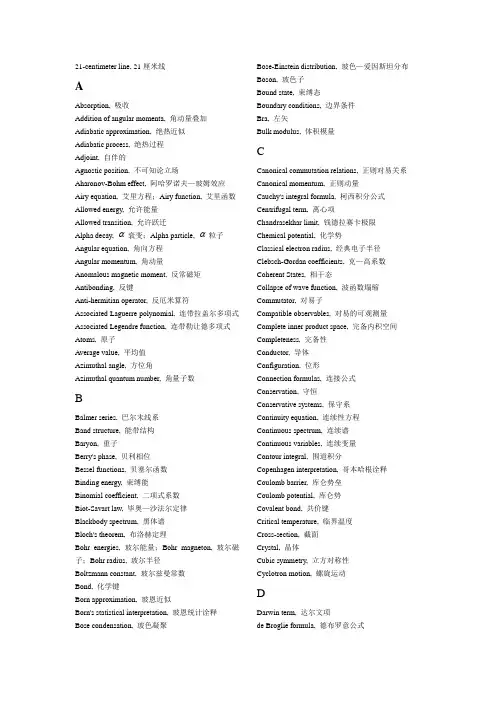
21-centimeter line, 21厘米线AAbsorption, 吸收Addition of angular momenta, 角动量叠加Adiabatic approximation, 绝热近似Adiabatic process, 绝热过程Adjoint, 自伴的Agnostic position, 不可知论立场Aharonov-Bohm effect, 阿哈罗诺夫—玻姆效应Airy equation, 艾里方程;Airy function, 艾里函数Allowed energy, 允许能量Allowed transition, 允许跃迁Alpha decay, α衰变;Alpha particle, α粒子Angular equation, 角向方程Angular momentum, 角动量Anomalous magnetic moment, 反常磁矩Antibonding, 反键Anti-hermitian operator, 反厄米算符Associated Laguerre polynomial, 连带拉盖尔多项式Associated Legendre function, 连带勒让德多项式Atoms, 原子Average value, 平均值Azimuthal angle, 方位角Azimuthal quantum number, 角量子数BBalmer series, 巴尔末线系Band structure, 能带结构Baryon, 重子Berry's phase, 贝利相位Bessel functions, 贝塞尔函数Binding energy, 束缚能Binomial coefficient, 二项式系数Biot-Savart law, 毕奥—沙法尔定律Blackbody spectrum, 黑体谱Bloch's theorem, 布洛赫定理Bohr energies, 玻尔能量;Bohr magneton, 玻尔磁子;Bohr radius, 玻尔半径Boltzmann constant, 玻尔兹曼常数Bond, 化学键Born approximation, 玻恩近似Born's statistical interpretation, 玻恩统计诠释Bose condensation, 玻色凝聚Bose-Einstein distribution, 玻色—爱因斯坦分布Boson, 玻色子Bound state, 束缚态Boundary conditions, 边界条件Bra, 左矢Bulk modulus, 体积模量CCanonical commutation relations, 正则对易关系Canonical momentum, 正则动量Cauchy's integral formula, 柯西积分公式Centrifugal term, 离心项Chandrasekhar limit, 钱德拉赛卡极限Chemical potential, 化学势Classical electron radius, 经典电子半径Clebsch-Gordan coefficients, 克—高系数Coherent States, 相干态Collapse of wave function, 波函数塌缩Commutator, 对易子Compatible observables, 对易的可观测量Complete inner product space, 完备内积空间Completeness, 完备性Conductor, 导体Configuration, 位形Connection formulas, 连接公式Conservation, 守恒Conservative systems, 保守系Continuity equation, 连续性方程Continuous spectrum, 连续谱Continuous variables, 连续变量Contour integral, 围道积分Copenhagen interpretation, 哥本哈根诠释Coulomb barrier, 库仑势垒Coulomb potential, 库仑势Covalent bond, 共价键Critical temperature, 临界温度Cross-section, 截面Crystal, 晶体Cubic symmetry, 立方对称性Cyclotron motion, 螺旋运动DDarwin term, 达尔文项de Broglie formula, 德布罗意公式de Broglie wavelength, 德布罗意波长Decay mode, 衰变模式Degeneracy, 简并度Degeneracy pressure, 简并压Degenerate perturbation theory, 简并微扰论Degenerate states, 简并态Degrees of freedom, 自由度Delta-function barrier, δ势垒Delta-function well, δ势阱Derivative operator, 求导算符Determinant, 行列式Determinate state, 确定的态Deuterium, 氘Deuteron, 氘核Diagonal matrix, 对角矩阵Diagonalizable matrix, 对角化Differential cross-section, 微分截面Dipole moment, 偶极矩Dirac delta function, 狄拉克δ函数Dirac equation, 狄拉克方程Dirac notation, 狄拉克记号Dirac orthonormality, 狄拉克正交归一性Direct integral, 直接积分Discrete spectrum, 分立谱Discrete variable, 离散变量Dispersion relation, 色散关系Displacement operator, 位移算符Distinguishable particles, 可分辨粒子Distribution, 分布Doping, 掺杂Double well, 双势阱Dual space, 对偶空间Dynamic phase, 动力学相位EEffective nuclear charge, 有效核电荷Effective potential, 有效势Ehrenfest's theorem, 厄伦费斯特定理Eigenfunction, 本征函数Eigenvalue, 本征值Eigenvector, 本征矢Einstein's A and B coefficients, 爱因斯坦A,B系数;Einstein's mass-energy formula, 爱因斯坦质能公式Electric dipole, 电偶极Electric dipole moment, 电偶极矩Electric dipole radiation, 电偶极辐射Electric dipole transition, 电偶极跃迁Electric quadrupole transition, 电四极跃迁Electric field, 电场Electromagnetic wave, 电磁波Electron, 电子Emission, 发射Energy, 能量Energy-time uncertainty principle, 能量—时间不确定性关系Ensemble, 系综Equilibrium, 平衡Equipartition theorem, 配分函数Euler's formula, 欧拉公式Even function, 偶函数Exchange force, 交换力Exchange integral, 交换积分Exchange operator, 交换算符Excited state, 激发态Exclusion principle, 不相容原理Expectation value, 期待值FFermi-Dirac distribution, 费米—狄拉克分布Fermi energy, 费米能Fermi surface, 费米面Fermi temperature, 费米温度Fermi's golden rule, 费米黄金规则Fermion, 费米子Feynman diagram, 费曼图Feynman-Hellman theorem, 费曼—海尔曼定理Fine structure, 精细结构Fine structure constant, 精细结构常数Finite square well, 有限深方势阱First-order correction, 一级修正Flux quantization, 磁通量子化Forbidden transition, 禁戒跃迁Foucault pendulum, 傅科摆Fourier series, 傅里叶级数Fourier transform, 傅里叶变换Free electron, 自由电子Free electron density, 自由电子密度Free electron gas, 自由电子气Free particle, 自由粒子Function space, 函数空间Fusion, 聚变Gg-factor, g—因子Gamma function, Γ函数Gap, 能隙Gauge invariance, 规范不变性Gauge transformation, 规范变换Gaussian wave packet, 高斯波包Generalized function, 广义函数Generating function, 生成函数Generator, 生成元Geometric phase, 几何相位Geometric series, 几何级数Golden rule, 黄金规则"Good" quantum number, “好”量子数"Good" states, “好”的态Gradient, 梯度Gram-Schmidt orthogonalization, 格莱姆—施密特正交化法Graphical solution, 图解法Green's function, 格林函数Ground state, 基态Group theory, 群论Group velocity, 群速Gyromagnetic railo, 回转磁比值HHalf-integer angular momentum, 半整数角动量Half-life, 半衰期Hamiltonian, 哈密顿量Hankel functions, 汉克尔函数Hannay's angle, 哈内角Hard-sphere scattering, 硬球散射Harmonic oscillator, 谐振子Heisenberg picture, 海森堡绘景Heisenberg uncertainty principle, 海森堡不确定性关系Helium, 氦Helmholtz equation, 亥姆霍兹方程Hermite polynomials, 厄米多项式Hermitian conjugate, 厄米共轭Hermitian matrix, 厄米矩阵Hidden variables, 隐变量Hilbert space, 希尔伯特空间Hole, 空穴Hooke's law, 胡克定律Hund's rules, 洪特规则Hydrogen atom, 氢原子Hydrogen ion, 氢离子Hydrogen molecule, 氢分子Hydrogen molecule ion, 氢分子离子Hydrogenic atom, 类氢原子Hyperfine splitting, 超精细分裂IIdea gas, 理想气体Idempotent operaror, 幂等算符Identical particles, 全同粒子Identity operator, 恒等算符Impact parameter, 碰撞参数Impulse approximation, 脉冲近似Incident wave, 入射波Incoherent perturbation, 非相干微扰Incompatible observables, 不对易的可观测量Incompleteness, 不完备性Indeterminacy, 非确定性Indistinguishable particles, 不可分辨粒子Infinite spherical well, 无限深球势阱Infinite square well, 无限深方势阱Inner product, 内积Insulator, 绝缘体Integration by parts, 分部积分Intrinsic angular momentum, 内禀角动量Inverse beta decay, 逆β衰变Inverse Fourier transform, 傅里叶逆变换KKet, 右矢Kinetic energy, 动能Kramers' relation, 克莱默斯关系Kronecker delta, 克劳尼克δLLCAO technique, 原子轨道线性组合法Ladder operators, 阶梯算符Lagrange multiplier, 拉格朗日乘子Laguerre polynomial, 拉盖尔多项式Lamb shift, 兰姆移动Lande g-factor, 朗德g—因子Laplacian, 拉普拉斯的Larmor formula, 拉摩公式Larmor frequency, 拉摩频率Larmor precession, 拉摩进动Laser, 激光Legendre polynomial, 勒让德多项式Levi-Civita symbol, 列维—西维塔符号Lifetime, 寿命Linear algebra, 线性代数Linear combination, 线性组合Linear combination of atomic orbitals, 原子轨道的线性组合Linear operator, 线性算符Linear transformation, 线性变换Lorentz force law, 洛伦兹力定律Lowering operator, 下降算符Luminoscity, 照度Lyman series, 赖曼线系MMagnetic dipole, 磁偶极Magnetic dipole moment, 磁偶极矩Magnetic dipole transition, 磁偶极跃迁Magnetic field, 磁场Magnetic flux, 磁通量Magnetic quantum number, 磁量子数Magnetic resonance, 磁共振Many worlds interpretation, 多世界诠释Matrix, 矩阵;Matrix element, 矩阵元Maxwell-Boltzmann distribution, 麦克斯韦—玻尔兹曼分布Maxwell’s equations, 麦克斯韦方程Mean value, 平均值Measurement, 测量Median value, 中位值Meson, 介子Metastable state, 亚稳态Minimum-uncertainty wave packet, 最小不确定度波包Molecule, 分子Momentum, 动量Momentum operator, 动量算符Momentum space wave function, 动量空间波函数Momentum transfer, 动量转移Most probable value, 最可几值Muon, μ子Muon-catalysed fusion, μ子催化的聚变Muonic hydrogen, μ原子Muonium, μ子素NNeumann function, 纽曼函数Neutrino oscillations, 中微子振荡Neutron star, 中子星Node, 节点Nomenclature, 术语Nondegenerate perturbationtheory, 非简并微扰论Non-normalizable function, 不可归一化的函数Normalization, 归一化Nuclear lifetime, 核寿命Nuclear magnetic resonance, 核磁共振Null vector, 零矢量OObservable, 可观测量Observer, 观测者Occupation number, 占有数Odd function, 奇函数Operator, 算符Optical theorem, 光学定理Orbital, 轨道的Orbital angular momentum, 轨道角动量Orthodox position, 正统立场Orthogonality, 正交性Orthogonalization, 正交化Orthohelium, 正氦Orthonormality, 正交归一性Orthorhombic symmetry, 斜方对称Overlap integral, 交叠积分PParahelium, 仲氦Partial wave amplitude, 分波幅Partial wave analysis, 分波法Paschen series, 帕邢线系Pauli exclusion principle, 泡利不相容原理Pauli spin matrices, 泡利自旋矩阵Periodic table, 周期表Perturbation theory, 微扰论Phase, 相位Phase shift, 相移Phase velocity, 相速Photon, 光子Planck's blackbody formula, 普朗克黑体辐射公式Planck's constant, 普朗克常数Polar angle, 极角Polarization, 极化Population inversion, 粒子数反转Position, 位置;Position operator, 位置算符Position-momentum uncertainty principles, 位置—动量不确定性关系Position space wave function, 坐标空间波函数Positronium, 电子偶素Potential energy, 势能Potential well, 势阱Power law potential, 幂律势Power series expansion, 幂级数展开Principal quantum number, 主量子数Probability, 几率Probability current, 几率流Probability density, 几率密度Projection operator, 投影算符Propagator, 传播子Proton, 质子QQuantum dynamics, 量子动力学Quantum electrodynamics, 量子电动力学Quantum number, 量子数Quantum statics, 量子统计Quantum statistical mechanics, 量子统计力学Quark, 夸克RRabi flopping frequency, 拉比翻转频率Radial equation, 径向方程Radial wave function, 径向波函数Radiation, 辐射Radius, 半径Raising operator, 上升算符Rayleigh's formula, 瑞利公式Realist position, 实在论立场Recursion formula, 递推公式Reduced mass, 约化质量Reflected wave, 反射波Reflection coefficient, 反射系数Relativistic correction, 相对论修正Rigid rotor, 刚性转子Rodrigues formula, 罗德里格斯公式Rotating wave approximation, 旋转波近似Rutherford scattering, 卢瑟福散射Rydberg constant, 里德堡常数Rydberg formula, 里德堡公式SScalar potential, 标势Scattering, 散射Scattering amplitude, 散射幅Scattering angle, 散射角Scattering matrix, 散射矩阵Scattering state, 散射态Schrodinger equation, 薛定谔方程Schrodinger picture, 薛定谔绘景Schwarz inequality, 施瓦兹不等式Screening, 屏蔽Second-order correction, 二级修正Selection rules, 选择定则Semiconductor, 半导体Separable solutions, 分离变量解Separation of variables, 变量分离Shell, 壳Simple harmonic oscillator, 简谐振子Simultaneous diagonalization, 同时对角化Singlet state, 单态Slater determinant, 斯拉特行列式Soft-sphere scattering, 软球散射Solenoid, 螺线管Solids, 固体Spectral decomposition, 谱分解Spectrum, 谱Spherical Bessel functions, 球贝塞尔函数Spherical coordinates, 球坐标Spherical Hankel functions, 球汉克尔函数Spherical harmonics, 球谐函数Spherical Neumann functions, 球纽曼函数Spin, 自旋Spin matrices, 自旋矩阵Spin-orbit coupling, 自旋—轨道耦合Spin-orbit interaction, 自旋—轨道相互作用Spinor, 旋量Spin-spin coupling, 自旋—自旋耦合Spontaneous emission, 自发辐射Square-integrable function, 平方可积函数Square well, 方势阱Standard deviation, 标准偏差Stark effect, 斯塔克效应Stationary state, 定态Statistical interpretation, 统计诠释Statistical mechanics, 统计力学Stefan-Boltzmann law, 斯特番—玻尔兹曼定律Step function, 阶跃函数Stem-Gerlach experiment, 斯特恩—盖拉赫实验Stimulated emission, 受激辐射Stirling's approximation, 斯特林近似Superconductor, 超导体Symmetrization, 对称化Symmetry, 对称TTaylor series, 泰勒级数Temperature, 温度Tetragonal symmetry, 正方对称Thermal equilibrium, 热平衡Thomas precession, 托马斯进动Time-dependent perturbation theory, 含时微扰论Time-dependent Schrodinger equation, 含时薛定谔方程Time-independent perturbation theory, 定态微扰论Time-independent Schrodinger equation, 定态薛定谔方程Total cross-section, 总截面Transfer matrix, 转移矩阵Transformation, 变换Transition, 跃迁;Transition probability, 跃迁几率Transition rate, 跃迁速率Translation,平移Transmission coefficient, 透射系数Transmitted wave, 透射波Trial wave function, 试探波函数Triplet state, 三重态Tunneling, 隧穿Turning points, 回转点Two-fold degeneracy , 二重简并Two-level systems, 二能级体系UUncertainty principle, 不确定性关系Unstable particles, 不稳定粒子VValence electron, 价电子Van der Waals interaction, 范德瓦尔斯相互作用Variables, 变量Variance, 方差Variational principle, 变分原理Vector, 矢量Vector potential, 矢势Velocity, 速度Vertex factor, 顶角因子Virial theorem, 维里定理WWave function, 波函数Wavelength, 波长Wave number, 波数Wave packet, 波包Wave vector, 波矢White dwarf, 白矮星Wien's displacement law, 维恩位移定律YYukawa potential, 汤川势ZZeeman effect, 塞曼效应。
4基金项目:国家自然科学基金面上项目(11975283);国家自然科学基金联合基金项目(U1632271);国家重大研发计划项目(2021YFA1601400)作者介绍:沈程(1995-),男,博士研究生,E-mail:*******************.cn;刘文静(1986-),博士,副研究员,E-mail:***************.cn。
*沈程和刘文静在本工作中做出了同等贡献。
通信作者:杜广华,男,中国科学院近代物理研究所,研究员,E-mial:***************.cn空间辐射环境模拟装置与空间辐射生物效应研究进展沈程1, 2, #,刘文静1, #,吴汝群1,郭金龙1,牟宏进1,张磊1, 2,赵灿1,毛光博1,杜广华1 2*(1.中国科学院近代物理研究所,甘肃,兰州,730000;2.中国科学院大学,北京,100049)Abstract: The high-energy ionizing radiation exposed to astronauts in the outer space come mainly derived from solar particle events, galactic cosmic rays and high-energy ions in the Earth's capture belt and their secondary radioactive particles. Space radiation exposure is characterized by low dose rates, multi-element radiation, and high linear energy transfer (LET), which are the main risk factors faced by astronauts during long-term space exploration missions in deep space. Space radiation simulation facilities at the ground-based high-energy accelerators and the study of the biological effects of space radiation are of great importance to the scientific grounding for space radiation risk assessment. As an advanced irradiation facility that can provide precise targeted irradiation with single ion, single-ion microbeam is a unique platform for biological effect research that simulates high-energy radiation conditions in space. This paper first introduces the radiation environment for near-Earth missions and deep space exploration, as well as particle accelerator facilities available in the world to carry out ground-based simulations of space radiation in recent years. Finally, the high-energy microbeam facility of Heavy Ion Research Facility in Lanzhou and its application in space radiation biology are introduced. .Progress in Ground-based Simulation Facilities for Space RadiationEnvironment and Their Biological Effects ResearchSHEN Cheng 1, 2, #, LIU Wenjing 1, #, WU Ruqun 1, GUO Jinlong 1, MOU Hongjin 1, ZHANG Lei1, 2, ZHAO Can 1,MAO Guangbo 1, DU Guanghua 1 2*(1. Institute of Modern Physics, Chinese Academy of Sciences, Lanzhou, Gansu,730000.2. University of Chinese Academy of Sciences, Beijing, 100049)摘要:空间环境中宇航员受到的高能辐射主要来源于太阳粒子事件、银河宇宙射线和地球捕获带中的高能离子及其次生放射性粒子。
高一英语物理学概念单选题50题答案解析版1.The boy pushed the box with a certain _____.A.forceB.energyC.powerD.strength答案:A。
“force”指力,符合男孩推箱子用一定的力这个语境。
“energy”是能量;“power”权力、动力等;“strength”力气,多指人的体力。
2.We get light and heat from the sun. This is a form of _____.A.forceB.energyC.powerD.strength答案:B。
从太阳得到光和热,这是一种能量的形式。
“force”力;“power”权力、动力等;“strength”力气。
3.When an object is lifted up, it gains _____.A.forceB.energyC.powerD.strength答案:B。
物体被举高时获得能量。
“force”力;“power”权力、动力等;“strength”力气。
4.The car has a lot of _____, so it can go very fast.A.forceB.energyC.powerD.strength答案:C。
汽车有很大的动力,所以能跑得很快。
“force”力;“energy”能量;“strength”力气。
5.To break a rock, we need a large _____.A.forceB.energyC.powerD.strength答案:A。
打破一块石头需要很大的力。
“energy”能量;“power”权力、动力等;“strength”力气。
6.The wind has enough _____ to move the sailboat.A.forceB.energyC.powerD.strength答案:A。
英语物理知识点总结人教版1. MechanicsMechanics is the branch of physics that deals with the study of motion, forces, and energy. It is a fundamental area of physics that underpins all other branches of the subject. In mechanics, we study the laws of motion, the behavior of objects under the influence of forces, and the transfer and transformation of energy. Some key topics in mechanics include:- Newton's laws of motion: These laws describe the relationship between the motion of an object and the forces acting on it. They are fundamental principles in the study of mechanics and provide a basis for understanding the behavior of objects in the physical world.- Kinematics: This is the branch of mechanics that deals with the description of motion without considering the forces that cause it. It includes the study of displacement, velocity, and acceleration.- Dynamics: Dynamics is the study of the forces that cause motion and the resulting motion of objects. It includes the study of force, mass, acceleration, and momentum.2. ThermodynamicsThermodynamics is the branch of physics that deals with the study of heat, temperature, and the relationship between energy and work. It is an important area of physics that has wide-ranging applications in engineering, chemistry, and environmental science. Some key topics in thermodynamics include:- Laws of thermodynamics: The laws of thermodynamics are fundamental principles that govern the behavior of energy and heat. They provide a framework for understanding the behavior of systems and the conversion of energy between different forms.- Heat transfer: Heat transfer is the study of the movement of heat from one place to another. It includes the processes of conduction, convection, and radiation, which are important in understanding the behavior of materials and systems.- Thermodynamic processes: Thermodynamic processes describe the changes in a system's state variables, such as temperature, pressure, and volume, as it undergoes a transformation. These processes are important in the study of energy conversion and the performance of heat engines and refrigeration systems.3. ElectromagnetismElectromagnetism is the branch of physics that deals with the study of electric and magnetic phenomena. It is a fundamental area of physics that has diverse applications in technology, from electronics and telecommunications to power generation and transportation. Some key topics in electromagnetism include:- Electric charge and field: Electric charge is a fundamental property of matter that interacts with other charges through the electric field. The study of electric fields and their effects provides a basis for understanding electrical phenomena.- Magnetic fields and forces: Magnetic fields are produced by moving charges and exert forces on other moving charges. The study of magnetic fields and their effects provides a basis for understanding magnetic phenomena and their applications.- Electromagnetic waves: Electromagnetic waves are energy-carrying waves that are generated by oscillating electric and magnetic fields. They play a crucial role in the transmission of information and energy and are fundamental in the study of light, radio, and other forms of electromagnetic radiation.4. OpticsOptics is the branch of physics that deals with the study of light and its interactions with matter. It is an important area of physics that has diverse applications in technology, from imaging and microscopy to telecommunications and laser technology. Some key topics in optics include:- Geometric optics: Geometric optics is the study of the behavior of light as it interacts with mirrors, lenses, and other optical components. It provides a basis for understanding the formation of images and the design of optical instruments.- Wave optics: Wave optics is the study of the behavior of light as a wave, including phenomena such as interference, diffraction, and polarization. It provides a basis for understanding the wave nature of light and its interactions with matter.- Modern optics: Modern optics encompasses the study of advanced optical phenomena and technologies, including laser physics, fiber optics, and the development of optical materials and devices. It is an important area of physics with wide-ranging applications in technology and industry.5. Modern physicsModern physics is the branch of physics that deals with the study of phenomena beyond the scope of classical physics, including quantum mechanics, relativity, and particle physics. It is a fascinating and rapidly advancing area of physics that has revolutionized our understanding of the physical world. Some key topics in modern physics include:- Quantum mechanics: Quantum mechanics is the branch of physics that deals with the behavior of matter and energy at the atomic and subatomic scales. It provides a basis for understanding the behavior of particles such as electrons and photons and has led to the development of new technologies such as quantum computing and quantum cryptography. - Special relativity: Special relativity is the theory developed by Albert Einstein that describes the behavior of objects moving at high speeds. It provides a basis forunderstanding the nature of space, time, and energy at relativistic velocities and has had a profound impact on our understanding of the universe.- Particle physics: Particle physics is the branch of physics that deals with the study of the fundamental particles and forces of nature. It has led to the discovery of new particles such as quarks, leptons, and bosons, and has played a crucial role in the development of the standard model of particle physics.In conclusion, physics is a fascinating and fundamental science that provides us with a deeper understanding of the physical world. The key concepts summarized in this article provide a comprehensive overview of the subject and its diverse applications in technology and industry. By studying physics, we can gain a better understanding of the principles that govern the behavior of matter and energy and develop new technologies to address the challenges of the future.。
专利名称:PARTICLE RADIATION DEVICE COMPRISINGA PARTICLE SOURCE THAT IS OPERATED INAN ULTRAHIGH VACUUM AND A CASCADEPUMP ASSEMBLY FOR A PARTICLERADIATION DEVICE OF THIS TYPE发明人:GNAUCK, Peter,DREXEL, Volker申请号:EP2001007597申请日:20010703公开号:WO02/005310P1公开日:20020117专利内容由知识产权出版社提供摘要:The invention relates to a particle radiation device comprising a particle source that is operated in an ultrahigh vacuum and a preparation chamber which can be operated using variable pressures of up to 1 hPa. The inventive particle radiation device has two intermediate pressure areas (7, 8) located between the ultrahigh vacuum area (6) and the preparation chamber (1). The two intermediate pressure areas (7, 8) are purged by means of a pump assembly consisting of a fore-pump (16) and two turbomolecular pumps (13, 14) connected in series, whereby one of the turbomolecular pumps (13) is purged first by the drag phase (24) of the other turbomolecular pump (14). In one example of the invention, the fore-pump (16) is also simultaneously used for evacuating the preparation chamber. In an alternative example, a second fore-pump (20) is provided for evacuating the preparation chamber (1). This assembly allows the ultrahigh vacuum in the ultrahigh vacuum area (6) to be maintained up to pressures of 100 hPa in the preparation chamber (1). The inventive particle radiation device is used in particular as avariable pressure scanning electron microscope (VP-SEM) or as an environmental scanning electron microscope (ESEM).申请人:GNAUCK, Peter,DREXEL, Volker地址:73446 Oberkochen DE,Glaserstrasse 4 72764 Reutlingen DE,Danzigerstrasse 3 89551 Königsbronn DE国籍:DE,DE,DE代理机构:GNATZIG, Klaus更多信息请下载全文后查看。
专利名称:IMPROVED RADIATION SENSOR, ANDAPPLICATION OF IMPROVED RADIATIONSENSOR IN CHARGED PARTICLEMICROSCOPE发明人:HERALD NICOLAAS ANNE VAN FEEN,ヘラルド ニコラース アンネ ファン フィーン,CORNELIS SANDER KOOIJMAN,コーネリスサンダー コーユマン,LUC ROGER SIMONNEHASPESLAGH,リュク ロジャー シモンヌ ハスペスラー申请号:JP2015161528申请日:20150819公开号:JP2016046529A公开日:20160404专利内容由知识产权出版社提供专利附图:摘要:PROBLEM TO BE SOLVED: To provide a sensor which can eliminate a trouble owing to the behavior of leakage current.SOLUTION: A CMOS radiation sensor 3 comprises a layer structure and is arranged to have pixels (e.g. in a 4T-embedded photodiode device). The layer structure has: a p-type Si substrate 5; an n-type doped region 7 in the substrate; a pdoped fixed layer 9 covering the n-type doped region; and a SiOlayer 11 covering the pdoped fixed layer and functioning as a metal film-underlying dielectric film or intermetallic dielectric film. The CMOS radiation sensor further comprises: a boron film 13 deposited between the pdoped fixed layer and the SiOlayer.EFFECT: Providing such a pure boron film reduces leakage current by at least one order. Even a relatively thin boron film (of a thickness of e.g. 1 to 2 nm) can produce the effect.SELECTED DRAWING: Figure 1申请人:エフ イー アイ カンパニ,エフ イー アイ カンパニFEI COMPANY代理人:伊東 忠重,伊東 忠彦,大貫 進介更多信息请下载全文后查看。
a r X i v :p h y s i c s /0602002v 1 [p h y s i c s .a c c -p h ] 1 F eb 2006RADIATION OF RELATIVISTIC PARTICLES FOR QUASIPERIODIC MOTION IN ATRANSPARENT MEDIUMS.Bellucci 1and V.A.Maisheev 21INFN -Laboratori Nazionali di Frascati,P.O.Box 13,00044Frascati,Italy2Institute for High Energy Physics,142281,Protvino,RussiaThe radiation of relativistic charged particles for the quasiperiodic motion in a transparent medium is considered.For motion of the general kind the differential probability of the process is obtained.For planar motion the spectral intensity of radiation is found.The different cases of radiation in the medium-filled undulators are studied.In particular,the influence of Cherenkov radiation on the undulator one is discussed.PACS number(s):41.60.-m I.INTRODUCTION At the present time such power sources of x-rays as undulators [1]are widely used in various fields of science.In a number of papers [2,3,4,5,6,7,8,9],with the aim of increasing of the energy of emitted photons,the crystal undulator was considered.The recent paper[10]contains a rather complete list of references related to various problem of crystal undulators [11].One of the proposed constructions [13,14]was created and tested in a positron beam.Preliminary results of the experiment [15]give an indication on the observation of undulator radiation.Calculations of the expected intensity for this experiment were based on the theory [16]of radiation for quasiperiodic motion in vacuum.This theory allows one to perform the calculation of radiation spectra for motion of the general type and different parameters of the undulator.In calculations with our experimental conditions we use the theory [16]in the frame of the classical electrodynamics.However,in the recent papers [17,18]the possibility of an appreciable influence of the medium polarization on the spectral intensity in crystal undulators was shown.In Ref.[17]the process was considered only in the dipole approximation.In Ref.[18]this process was studied for a specific construction of the undulator and hence for specific trajectories of particles.In both cases the radiation of the first harmonic was considered.In this paper we want to extend the theory [16]to the case of a transparent medium.We will study the pointed process in the general case of dielectric function ε(ω)(where ωis the frequency or energy of the emitted photon),which may be larger or smaller than 1.The arising phenomena in different cases will be shortly discussed.In this paper we employ units such that ¯h =c =1.Note that a large number of problems of radiation for charged particles moving in various media were considered in Ref.[19].Here the investigations of the radiation in medium-filled undulators are also presented.However,these results concern mainly the total radiation intensity.We also point out the paper [20]where the radiation for quasiperiodic motion was studied in a wide range of undulator parameters.II.RADIATION ENERGY LOSSES OF PARTICLE The well-known formula [21,22]for the radiation energy losses of a moving particle takes into account the dielectric function of the medium.The analogous formula in [16]differs from the above pointed one and was obtained for the vacuum.With the aim of extending of the theory [16](in the frame of the classical electrodynamics)to the case of a transparent medium we should find its corresponding representation.The Fourier transform of the vector potential for the electromagnetic field of a charged particle moving in the isotropic transparent medium has the following form [22]:A (ω,r )=e exp [ikr ]εωn ,ε(ω)is the dielectric function (εis a real positive value),n is the unit vector in the direction ofthe photon motion,v ,r 0are the particle velocity and its radius-vector,r is the distance from the point,where the particle (with the charge e)is located in the moment of time t .This relation is valid for large r .Using this equation we find (analogously to [16])the magnetic and electric (E )fields.The radiated energy d E (n ,ω)in an elementary solid angle d Ωand a frequency range ω,ω+dωfor the whole time of the process is [23]d E (n ,ω)=√Finally,we obtaind E(n,ω)=e2√(2π)2dt1dt2.(3)This equation describes the differential radiation energy losses of the relativistic particle moving in a transparent medium.At√ε(v2−1/ε)T mδ(ω−√2π,(4)where T m is the time of a particle motion andθis the polar angle,which determined by the pair of vectors:v and n. From here,we get the intensity of radiation per unit timed E(ω)εωnr0(t),ϕ0=ωT(1−√v2⊥γ2)/(2γ2),v ≈1−(1+v2⊥γ2)/(2γ2),(8) whereεω2dωdΩε=1+(√εnr0ω=−χωt+√2+tϕ0/T=ω(−χ+√v2⊥γ2)εθ2εω2dωdΩω0γ2∞n=−∞δ(ϕ0−2πn)[{(ε−1)4γ2−1}|I0|2+γ2(|I⊥|2−ReI∗0I )],(12)I0= 2π0e if(ψ)dψ,I⊥= 2π0v⊥(ψ)e if(ψ)dψ,(13)I = 2π0v⊥2(ψ)e if(ψ)dψ,ψ=ω0t,(14)f(ψ)=nψ+ω√εnx⊥(ψ),(15)where∆(t)=ω0 t0(v2⊥(t′)−√ε),(17)θ2=1√√v2⊥.Obviously,these relations are not independent and we write them for convenience of the furtherdiscussion.Eqs.(12)-(15)describe the spectral-angular distribution of the relativistic particle radiation for the quasiperiodic motion in the transparent and isotropic medium.The trajectory of the particle are represented in these equations in a general form.Eqs.(12)-(15)allow us to calculate the spectral(integrated over angular variables)intensity,with the help of numerical methods,for any particle motion.However,for some general enough cases the integrals in Eqs.(13)-(15)may be taken over angular variables so as,for example,in the important case of the planar motion.For the planar motionnx⊥=θcos(ϕ) t0v⊥(t′)dt′,(19) whereϕis the azimuthal angle.After integration overθwe getdI p=e2ωdωdϕεγ2+1dω=−e2ωε t1t2dψg(ψ) ε−ξ(1+ρ/2−2χγ2/√εγ2+1εξρ/2)(t1−t2)+√dω=e2ω∞n=−∞,=0ϑ(θ2)|x n|2{n2−2[ε−(ε−1)γ2][ξ(n/√ε))]},(22)where x n=(1/(2π) π−πx(ψ)exp(−inψ)dψis the Fourier component of the value x(t)=1/γ t0g(ψ)dψ(x(t)/ω0is the transversal coordinate).This equation was obtained for the two conditions:εω2θ2ρ/γ2≪1andρ√ε>1+ρ/2(23) the following term(n=0)should be added in Eq.(22):dI n=0ε+1γ2)−((ε−1)γ24γ2−1)[2εξ2(2χγ2√X2},(24)whereε<1+ρ/2only positive numbers n are possible.IV.EXAMPLES OF CALCULATIONSIn this section we point out the basic peculiarities of the radiation for quasiperiodic particle motion in the medium. For the detail description of this process the knowledge of explicit form of the dielectric function is important.The aim of our consideration is the application of the equations obtained in the previous section to the calculations of radiation processes in a transparent medium.Note that many peculiarities of similar processes were discussed in earlier papers[17,18,19,20,25,26,31,32,33]In the general case the relations obtained here for radiation in a medium are valid,at the condition of a small influence of this media on the quasiperiodic particle motion.The different processes(multiple scattering,ionization energy losses and others)can modify the motion of particles and they should be investigated separately.Various examples of consideration of this problem can be found in the literature[16,22,24].One can assert that,in the case of small enough values of|ε−1|,the influence of the medium on the motion will be insignificant,but in every specific case such a possibility should be studied.Thus,we think that in most,if not all,of the practically important cases one has|ε−1|≪1.It is a well-known fact that the transparent medium is an idealized substance.We assume that a good model of the transparent media is the media in whichε”≪|ε−1|,whereε”is the imaginary part of the dielectric function. In the general case the numbers of harmonic n,which may be radiated,lie in the range(−∞,∞).In the vacuum n≥1,always.However,at the condition2χγ2/√ε=1+ρ/2is practically equal to the threshold of the Cherenkov radiation.From Eq.(33)it follows that,at the decreasing of the amplitude of the transversal motion(ρ→0),this equation describes the intensity of the Cherenkov radiation.Besides,dI(n=0)/dω=0at2χγ2/√v2⊥and hence we canfind the threshold value of the Lorentz factor for Cherenkov radiationin the general caseγ2th=1ε−v2⊥<2χ/√γ2(2χγ2ε−1−ρ/2).(26)This result shows that the angle of Cherenkov radiation also depends on theρ-value.From Eq.(17)we see that no limitations on the energy of the emitted photons(for n=0).Now we consider the case of the usual amorphous media.At high enough frequencies of photons the dielectric function has the following simple form:ε=1−Ω2p1+ρ/2and the resolved photons energies lie in the intervalω−≤ω≤ω+,whereω±=γ2nω0± 1+ρ/2.(29) The threshold value of the Lorentz factor for the harmonic number n is equal toγth=Ωpn2ω20−ω02n. These results are in agreement with those in[17,18](for the1st harmonic)and[32].It is well known that in usual media the dielectric function is smaller than1at high enough photon energies.Thus, the Cherenkov undulator radiation is possible mainly at the photon energies<∼10eV.Besides,there exists the possibility to observe this radiation on the photoeffect absorption edges[25,26].In this case the energy of emitted photons has a value<∼1KeV.In accordance with quantum electrodynamics[27]the electromagnetic vacuum represents the medium in which the dielectric function may be larger than1.However,for electricfields which may be obtained in laboratories(<106 gauss)the valueε−1is very small and the particles with Lorentz factors larger than1010can feel this value.In paper [28]the Cherenkov radiation was predicted in silicon single crystals(i.e.the analogue of the quantum undulator)for particles withγ>108.However,our considerations allow us to predict the specific radiation of negative harmonics in single crystals.A similar effect is also applied to the propagation of high energy charged particles in power laser waves[29,30].Below we present some examples of calculations of the radiation of relativistic particles for quasiperiodic motion in the medium.These calculations were done with the use of Eq.(21)assuming that the particle motion in the transversal plane is harmonic:v⊥=aω0cosω0t.Figs.1and2illustrate the influence of media on the radiation in the crystal undulator[13,14,15].In the silicon single crystal at photon energies larger than10KeV the dielectric function is smaller than1.The disappearance of thefirst harmonic in such media is shown in Fig.1.Fig.2illustrates the medium influence in the case when thefirst harmonic is partially radiated.Notice that thesefigures were made only for aim of illustration and do not take into account many peculiarities of the real process(such as the influence of the channeling motion,etc.).Let us consider the particle radiation in the undulator with the dielectric function larger than1.In practice it may be a gas-filled undulator.Let the energy of particles moving in the undulator satisfy the condition for Cherenkov radiation(see Eq.(26)).Then the connection between the angle of radiation of the n-th harmonic and the angle of the Cherenkov radiation follows from Eq.(18)θ2(n)=θ2Ch+2nω0εω.(31)From here,we get that the condition of radiation of the n-th harmonic isn>−θ2Ch√2ω0.(32)Obviously all the positive n satisfy this condition and negative n satisfy Eq.(26)starting from some number n min.Let us imagine a medium with constant dielectric function(ε>1)for all photon energies.From our consideration (see Eqs.(25),(26),(31),(32)and the condition for the Cherenkov radiation to take place)it follows that in this medium the positive harmonic is radiated at all photon energies.There is a threshold for negative harmonics in this medium. In this case the radiation of these harmonics takes place at all above-threshold energies,and with the increasing of photon energy the number of radiated harmonics also grows.In particular,the frequencyω0determines only the threshold energy of radiated harmonics.This consideration shows that the character of radiation(at the pointed conditions)is appreciably different than in the usual undulator.For illustration of this case we carry out the calculation of the propagation of the beam with the Lorentz factor equal to400in the gas-filled undulator with a period equal to10cm.We also assume the valueχ=10−4at photon energies lower than1eV,andχ=0at energies higher than1eV.This value is several times smaller than in many gases at the atmospheric pressure.The energy range of photons corresponds approximately to visible light.Fig.3 illustrates the spectral intensity of the radiation atρ=0.39.In this case harmonics with the numbers-1,0,1are predominantly radiated.We see that at small energies the radiation of the zeroth harmonic dominates(in accordance with Eq.(24)).The total intensity grows proportionally to the photon energy and hence is equal to the intensity of Cherenkov radiation in any medium,which is characterized by the correspondingε-value.Fig.4illustrates the behavior of the intensity of radiation,depending on theρ-parameter.One can see that atρ≈62 the intensities of all the negative and zeroth harmonics disappear.The structure in curves at large enoughρreflects the disappearance of the negative harmonics.The peak atρ≈38corresponds to the harmonic with n=−3.At the√fixed Lorentz factor one has a threshold valueρth=4χγ2/[10]A.V.Korol,A.V.Solov’yov,and W.Greiner,Intern.Journal of Mod.Phys.13,867(2004).[11]We,following the authors of Ref.[3,12]of one thefirst publication in thisfield)cannot agree with some statements of thearticle[10]which touch upon some historical aspects and assessments of the contribution of different authors to this issue.[12]V.G.Baryshevsky,(Private communication).[13]S.Bellucci,S.Bini,V.M.Biryukov,Yu.A.Chesnokov,S.Dabagov,G.Giannini,V.Guidi,Yu.M.Ivanov,V.I.Kotov,V.A.Maisheev,C.Malag,G.Martinelli,A.A.Petrunin,V.V.Skorobogatov,M.Stefancich,D.Vincenzi Phys.Rev.Lett.90, 034801(2003);S.Bellucci,Nucl.Instr.Meth.B234,57(2005);S.Bellucci,3rd ICEM,Proc.of SPIE vol.5852(2005),p.276.[14]S.Bellucci,S.Bini,G.Giannini,V.M.Biryukov,G.I.Britvich,Yu.A.Chesnokov,V.I.Kotov,V.A.Maisheev,V.A.Pikalov,V.Guidi,C.Malagu,G.Martinelli,M.Stefancich,D.Vincenzi,Yu.M.Ivanov,A.A.Petrunin,V.V.Skorobogatov,F.Tombolini,Phys.Rev.ST AB7,023501(2004);V.M.Biryukov,S.Bellucci,Nucl.Instrum.Meth.B234,99(2005);V.M.Biryukov,S.Bellucci,Nucl.Instrum.Meth.B230,619(2005).[15]V.T.Baranov,S.Bellucci,V.M.Biryukov,G.I.Britvich,C.Balasubramanian,V.Guidi,G.Giannini,V.N.Zapolsky,V.I.Kotov,A.E.Kushnirenko,V.A.Maisheev,G.Martinelli,an,V.A.Pikalov,V.I.Terekhov,U.Uggerhoj,V.N.Chepegin and Yu.A.Chesnokov,JETP Letters,82,562(2005);A.G.Afonin,V.T.Baranov,S.Bellucci,V.M.Biryukov,G.I.Britvich,V.N.Chepegin,Yu.A.Chesnokov,C.Balasubramanian,G.Giannini,V.Guidi,Yu.M.Ivanov,V.I.Kotov,A.Kushnirenko,V.A.Maisheev,C.Malagu,G.Martinelli,A.A.Petrunin,V.A.Pikalov,A.Raco,V.V.Skorobogatov,M.Stefancich,V.I.Terekhov,F.Tombolini,D.Vincenzi,Nucl.Instrum.Meth.B234,122(2005);V.M.Biryukov,A.G.Afonin,V.T.Baranov,S.Baricordi,S.Bellucci,G.I.Britvich,V.N.Chepegin,Yu.A.Chesnokov,C.Balasubramanian,G.Giannini,V.Guidi,Yu.M.Ivanov,V.I.Kotov,A.Kushnirenko,V.A.Maisheev,C.Malagu,G.Martinelli,an,A.A.Petrunin,V.A.Pikalov,V.V.Skorobogatov,M.Stefancich,V.I.Terekhov,F.Tombolini,U.I.Uggerhoj,”Accelerator Tests of Crystal Undulators”,physics/0412159;S.Bellucci.Mod.Phys.Lett.B19(2005)85.[16]V.N.Baier,V.M.Katkov,V.M.Strakhovenko,Electromagnetic processes at high energies in oriented single crystals,Singapore,Singapore World Scientific,1998.The chapter1contain the theory of radiation for the quasiperiodic motion(in the frame of classical electrodynamic).[17]R.O.Avakian,L.A.Gevorgian,K.A.Ispirian,R.K.Ispirian Nucl.Instr.and Meth.B173112(2001).[18]R.O.Avakian,L.A.Gevorgian,K.A.Ispirian,A.H.Shamamian Nucl.Instr.and Meth.B227104(2005).[19]V.L.Ginzburg Applications of Electrodynamics in Theoretical Physics and Astrophysics.New York,Gordon and Breach,Sci.Publ.,1989.[20]L.A.Gevorgian,N.A.Korkhmazian,Zh.Eksp.Teor.Fiz.76,1226(1979).[21]J.D.Jackson,Classical Electrodynamics,John Wiley,New York,1962.[22]M.L.Ter-Mikaelian,High Ehergy Electromagnetic Processes in Condensed Media(Wiley,New York,1972).[23]ndau and E.M.Lifshitz,Electrodynamics of Continuous Media,2nd ed.,Pergamon Press,New York(1984).[24]S.Bellucci and V.A.Maisheev,Phys.Rev.B71,174105(2005).[25]V.A.Bazylev,V.I.Glebov,E.I.Denisov,N.K.Zhevago,A.S.Khlebnikov,V.G.Tcinoev,Sov.Phys.JETP54,884(1981).[26]M.J.Moran,B.Chang,M.B.Schneider,X.K.Maryyama Nucl.Instr.Meth.B48,287(1990).[27]V.B.Berestetskii,E.M.Lifshitz,L.P.Pitaevskii,Quantum Electrodinamics,Pergamon,Oxford,1982.[28]V.A.Maisheev,V.L.Mikhalev,A.M.Frolov Sov.Phys.JETP74,(1992)740.[29]V.A.Maisheev,J.Exp.Theor.Phys.85,1102(1997)[Zh.Eksp.Teor.Fiz.112,2016(1997)].[30]I.M.Dremin,JETP Lett.76,151(2002)[Pisma Zh.Eksp.Teor.Fiz.76,185(2002)][arXiv:hep-ph/0202060].[31]V.G.Baryshevsky and I.Ya.Dubovskaya,Dokladi Akademii Nauk SSSR231,1335,(1976).[32]V.A.Bazylev and N.K.Zhevago Zh.Eksp.Fiz.73,1697(1977).[33]X.Artru,S.P.Fomin,N.F.Shul’ga,K.A.Ispirian,N.K.Zhevago Physics Reports412,89(2005).VII.FIGURE CAPTIONSFig.1Intensity of radiation in a silicon crystal undulator with the period and amplitude equal to0.05cm and100 angstrom,respectively.The energy of the positron beam is10GeV.Thin and thick curves correspond to radiation in vacuum and media,respectively.The parameterρhas the valueρ=6.4.Fig.2.The same as in Fig.1,but with the amplitude a=55angstrom andρ=1.83.Fig.3Intensity of radiation in gas-filled undulator as a function of the photon energy.Curves-1,0,1correspond to radiated harmonics with n=-1,0,1.The thick curve is the total intensity.The dotted curve is the intensity in vacuum enlarged500times(with the values of the other parameters remaining unchanged).Fig.4Intensity of radiation in gas-filled undulator as a fuction ofρ-parameter.Curve0corresponds to the zeroth harmonic,curve1(-1)corresponds to the sum of intensity of all the positive(negative)harmonics.The thick curve is the total intensity.The energy of radiated photons is equal to1eV.Fig.5Radiation of the harmonics in the gas-filled undulator.The angleθis along the abscissa axis and the intensity of radiation of the n-th harmonic is along the ordinate axis.The numbers above intercepts,showing the intensity,are the numbers of the harmonics.The intensity of the6th and7th harmonics are invisible(due to their small values). The energy of radiated photons is equal to1eV.The angleθfor the0-th harmonic is independent of the photon energy and for other harmonics these angles are changed in accordance with Eq.(31).The parameterρtakes the value ρ=3.8.FIG.1:FIG.2:FIG.3:FIG.4:FIG.5:。